Aperture's Blog, page 70
June 24, 2020
The Fashion Image after Nan Goldin
If fashion photography is defined by artifice, why does the industry crave rawness and reality?
By Lou Stoppard

Annie Powers, Vincenzo, Italy, 2018
Courtesy the artist
According to many, fashion is superficial—it is about surface, exaggeration, frivolity. It is, both as a sensibility and a process (the act of getting dressed), about adopting and embracing a disguise, a cover-up. Fashion, at its best and its worst, relies on an acceptance of the fake—the external. Fashion photography is, then, a festival of trickery, a heady, multilayered performance.
Ironic, then, that Nan Goldin, a photographer whose work is so frequently described as “truthful,” who makes pictures about the internal—pictures that, like jolts to the heart, move us, through the sheer relief of recognition and emotional relatability—is a fan of the fashion image. Goldin discovered fashion photography in the early 1970s through the work of Guy Bourdin. She was particularly enamored with his shoe advertisements for Charles Jourdan and his 1976 lingerie catalog for Bloomingdale’s, Sighs and Whispers (incidentally, the only “book” of Bourdin’s work published during his lifetime).
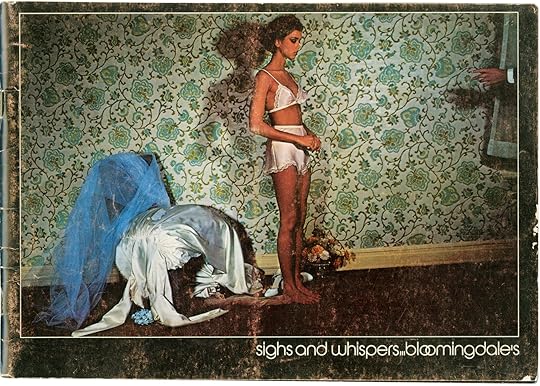
Cover of Bloomingdales’s Sighs and Whispers catalog, 1976, with photography by Guy Bourdin
Goldin also loved Cecil Beaton and Louise Dahl-Wolfe, who was a pioneer in getting models out of the studio and to locations. Writing in Nan Goldin (2010), Guido Costa says that Goldin’s early works “aspire to a sort of fashion-magazine glamour, and look more towards Vogue than to the classical traditions of photography.” And yet, he says, “There is too much life, too much truth in them—consciously or unconsciously, they reject entirely the language of pretense or illusion. In short, these photographs have the roughness typical of reportage, but their context is different, more intimate and private, more participatory.”
It is the “truth,” to quote Costa, in Goldin’s images that has shaped the significant influence her work has had on young image makers and, in a vaguely appropriate cycle, within the landscape of fashion publishing, where her pictures have been rehashed, referenced, and everything in between.
In the 1990s, one saw the specter of The Ballad of Sexual Dependency (1983–2008) in the goading grittiness of Corinne Day, whose images pushed for a balance of shock and tenderness toward her waifs and strays. In her personal writings, Day described discovering the book during a 1992 trip to New York, at a time when she was trying to convey her experiences through commercial magazines. “I wanted the ordinary person to see real life in those pages,” she writes. “I found Nan Goldin’s and Larry Clark’s work liberating and their work also validated the way I had started to take photographs myself.”

Corinne Day, Tania colouring her hair, 1995
© Estate of Corinne Day and courtesy Trunk Archive
During the fashion magazine boom of the 1990s, dirt, heartbreak, hedonism, and, on occasion, drug use became something like props, wheeled out to convey rebellion or cool. Such a look is neatly summarized in Fashion: Fashion Photography of the Nineties (1998), in which we see Day’s subjects thrashing around in run-down apartments and hotel rooms. We see Kristen McMenamy, half-dressed, a fine, thin scar on her belly, lipstick scrawled on her skin, in images by Juergen Teller from 1996. We see fraying carpets and chipped paintwork and rumpled bedding and discarded clothes and as-they-are models with charged yet insouciant expressions in work by Jack Pierson, Paolo Roversi, Wolfgang Tillmans, and their peers.
Today, Goldin’s influence can be seen in the vogue for fashion images that seemingly appear raw, real, authentic (a word that litters contemporary culture), or simply unretouched. The desire among young photographers to make such images is sparked, in part, by the success of newer image makers such as Ethan James Green (a Goldin admirer) and Jamie Hawkesworth (a devotee to Nigel Shafran, another champion of understated poignancy and realism), who have attracted commissions for their easy daylight, apparently stumbled-upon locations, and often street-cast subjects.
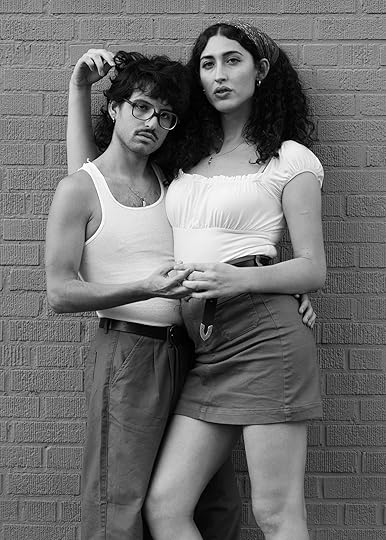
Ethan James Green, Peter and Stevie, 2019
Courtesy the artist
We see Goldin’s shadow on the balance of explicit sensuality and gentleness in Markn Ogue’s Lovers Series (2016–ongoing), which shows young couples entwined. We see it in the calm quietness of Jesse Gouveia’s images. We see it in the liberated, unselfconscious subjects in the work of Annie Powers. We see it in the conviction Guen Fiore has in the importance of showing women’s bodies as they are. Fiore cites Goldin as a key inspiration, pointing to images such as Amanda crying on my bed, Berlin (1992) and Rise and Monty kissing, New York City (1980) as references. “I like to think that I can bring back a hint of honesty in my work, proposing a variety of young women portrayed with simplicity,” she says.
Fashion has flirted with truth pre-Goldin. In the catalog for the Face of Fashion, an exhibition staged at London’s National Portrait Gallery in 2007, Vince Aletti writes, “Fashion magazines have always had a troubled relationship with reality; it’s often in their interest to keep it at bay.” Yet, he continues, they are in tune with cultural shifts. “After the austerity, sacrifice and can-do pluck of the war years, the exuberance of the late 1940s and 1950s was tempered with a new sense of realism . . . the gilt-edged romantic fantasies and neoclassic conceits of an earlier era gave way to a kind of stylized reportage. . . . Authenticity replaced theatricality.”

Markn, Lovers Series – CJ and Kaine, 2016
Courtesy the artist
One doesn’t need to look far to identify sociocultural reasons for the current quest for a semblance of authenticity or truth. Is it a reaction to the explosion of fashion images in other, new, contexts, beyond the magazine—e-commerce images, influencer selfies, Instagram posts—most of which embrace a sort of sanitized, pouty, cartoonish quality, their tweaking done, in many cases, via apps such as Facetune rather than Photoshop? Or is it that in times of climate crisis, when issues of sustainability are more visible, something that promotes high production, or high glamour, simply feels in bad taste? Perhaps, one could simply put it down to cycles; few could argue with the view that nostalgia is rampant in creativity today.
This focus on authenticity has to do with issues of representation. For so long, fashion failed to expand its vision beyond a thin, white body; image by image, it proved itself a censorious critic of anything beyond this narrow fantasy. Today, forums for criticism have expanded; the backlash is loud. “Fashion changes direction every time society is asking for something new and different,” says Fiore. “Nowadays people have a strong voice and are demanding for a more realistic standard of beauty, minorities want to be represented. Beauty as we knew it almost doesn’t exist anymore.”
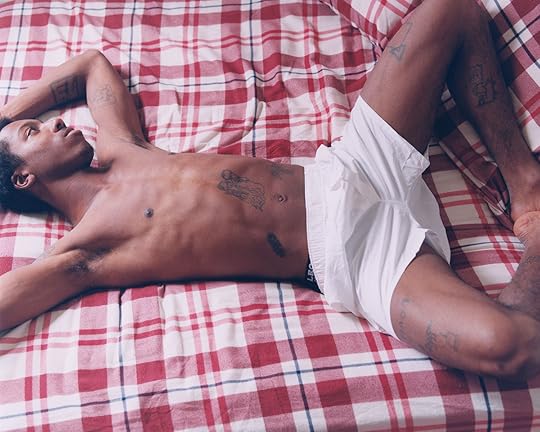
Jesse Gouveia, Boy’s Room, 2019
Courtesy the artist
“For fashion today, reality often means casting people who don’t look like models,” says Gouveia. “Five years ago, you couldn’t use a kid in a piece of your own personal work and then have a commercial client come along and use that same kid on a billboard. It feels significant. People really want to be a part of movements in image making—they think, I believe in those kinds of pictures so I want to make those kinds of pictures.”
Today, a moral quality is given to fashion images that look like real life—they are presented as a step forward. One must be careful, however, to recall that the agents of construction—the stylist, the glam team, the casting agent, the location scout—are still at work; their contributions have just been better disguised. Clients are usually moneymen—they see that a veneer of realism edifies the product, the brand, the consumption, and makes people feel better. Look, it’s just a girl on the street, just like you. “It’s meant to come across as reality, but really it has so many filtrations happening,” says Gouveia. “A model could have just walked into the studio an hour before, maybe she doesn’t know the photographer, she has her hair and makeup done, but it’s sold as something intimate or private.” To acknowledge that this is not a documentary image, and to do so boldly, is perhaps more honest: “Is it ‘realer’ for a fashion shoot to look like a fashion shoot—to show the glitter?”
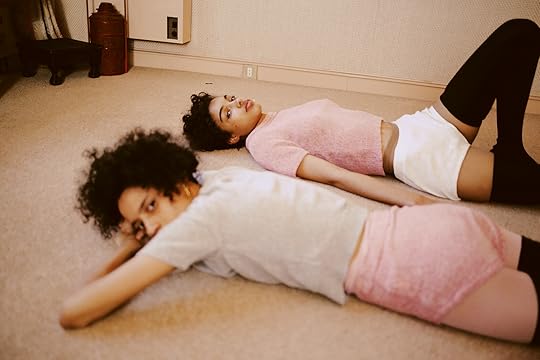
Guen Fiore, Samantha and Alyssa, for Jalouse magazine, Paris, 2019
Courtesy the artist
In general, truth is a dangerous word when one is talking of photographs. The relationship between the two has been thrashed out by thinkers since the medium’s inception. In Diving for Pearls, Goldin’s 2016 book, Glenn O’Brien writes, “From its beginning, photography has been the most magical medium and in art, entertainment, and propaganda, it is the greatest liar of all, making the impossible appear palpably true and validating falsehoods.” The title nods to a quote from Goldin’s friend, the photographer David Armstrong, who said that making pictures is like “diving for pearls.” Goldin writes of his observation that “if you took a million pictures you were lucky to come out with one or two gems.” As implied, the editing process moves an image further away from reality—the banal or mediocre, the uneventful (the humble context, perhaps) are removed.
“Most people don’t really understand what photography is,” says Nick Knight, the British fashion image maker. He is drawn to the craft of making pictures—elaborate lighting, experimental postproduction techniques—though his early documentary Skinhead project (1982) has had a great influence on numerous photographers. (He argues that his heavily worked fashion images are no less “truthful” than his Skinhead images, as his intentions—the desire to “show people things they cannot see”—were the same.) Knight prefers the title image maker to photographer. “The sooner that we understand that photography and image making, are not in any way to do with the portrayal of reality, the better,” he says. “Humans experience reality as a progression of emotions and desires and fears and loves, different feelings which are based on what’s just happened, what’s happening next.” A single snippet can never show that. And photographers will always manipulate, however subtly, whether with the lens, the printing, the shadows, the contrast, or the “diving” Nan refers to. According to Knight, “The idea that it’s all down to the moment when the shutter lifts and the light-sensitive material is exposed, and nothing else outside of that is valid or true, is a real misunderstanding of photography.”
The “real” look, Knight reminds, is just “another filter.” “Nan’s pictures are great love poems they speak about the difficulties, and the beauty, of life. You connect with the emotions, not the surface plasticity of the image. Of course, the plasticity can easily be reproduced for scenes that don’t have any depth of emotion.”
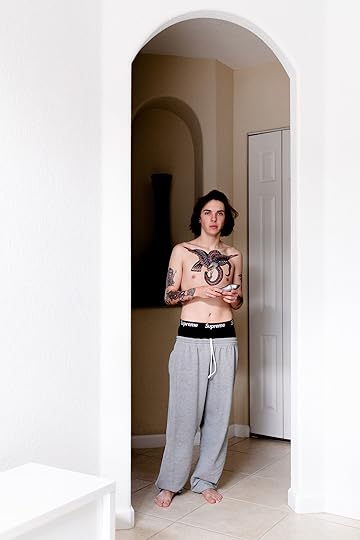
Maxwell Granger, Max at Andre’s grandparents’ house, Miami, 2019
Courtesy the artist
Maxwell Granger, a young image maker from the North of England, whose portraits are unfussy and vaguely droll, is similarly wary of the many fashion briefs asking for relatable, so-called authentic images. “No one really knows what that means,” he says. “People seem to think that something that looks candid is authentic, but I don’t believe that. There is this trend for images where people are not posed—but to get someone to stand there and ‘not pose’ is, if course, posing them. Take my mum, if she had a picture taken of her, it wouldn’t be authentic for her to just candidly stand there. It would be authentic for her to pose, because that is who she is.”
The idea that artifice can be somehow truthful is central to understanding Goldin’s work. This is where her understanding of fashion is so interesting—she sees that the surface is central to our sense of self, to the process of being, to happiness, confidence, love, life itself. She takes stylization seriously; it’s obvious from her photographs of great looks, of performers and drag queens, of nights out dressed up, of makeup smeared and newly applied. Look, she seems to say, The surface creation may speak more of reality than the unmarked, untweaked body underneath. Look again: Isn’t all self, all gender, simply a performance? In that case, how can any photograph be truthful if the subject matter, the person in it, is a construction—an act, a cover-up, a dreamed-up fantasy?
Hilton Als put it best in his 2016 profile in The New Yorker, “Nan Goldin’s Life in Progress,” when discussing Goldin’s images of the performer Suzanne Fletcher in The Ballad of Sexual Dependency. “The images are a tender evocation of a young woman who shows the camera as much of her real self as she can.” As much of her real self as she can. And, in turn, the camera captures as much as it can, and as much as Goldin intends (and, to an extent, as much as a certain slither of chance allows). Goldin is aware of the camera’s slippery nature, savvy to its limitations, serious about its power. The punch is the pathos—what we read into each image, what we imagine, and how much of ourselves we bring along to each viewing.
Lou Stoppard is a writer and curator based in London. She is the editor of Fashion Together: Fashion’s Most Extraordinary Duos on the Art of Collaboration (2017), Shirley Baker (2019), and Pools: Lounging, Diving, Floating Dreaming: Picturing Life at the Swimming Pool (2020).
Read more from Aperture, issue 239, “Ballads,” or subscribe to Aperture and never miss an issue.
June 18, 2020
Clifford Prince King’s Intimate Photographs of Black Queer Men
Creating tender scenes with friends and lovers, the LA-based artist offers a stirring vision of everyday ritual.
By Marjon Carlos
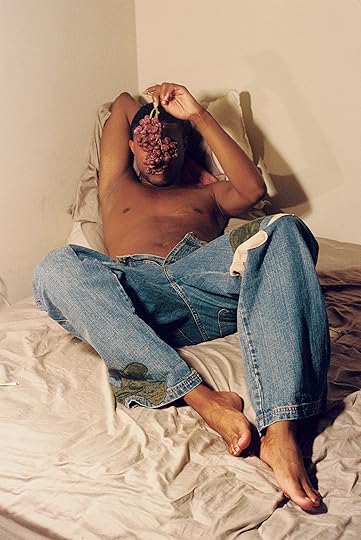
Clifford Prince King, Untitled (Grapes), 2017
Courtesy the artist
What’s remarkable about Clifford Prince King is his ability to make strangers seem both intimate and removed in his work. There is a sense of perceived recognition with his images. Friends of friends you’ve been meaning to meet are within the frames. The faces of under-the-radar creatives whose work you respect but have never told so in person peer back at you. “Oh, I know him,” you hear yourself say to no one in particular as you gaze on the heartbreakingly youthful subjects that make up King’s world. Queer Black men—friends, lovers, some nebulous place in between—lying languidly across bare apartments, cornrowing each other’s hair, holding blunts to one another’s mouths, or staring meditatively away from the camera, naked. The viewer is able to gain what King describes as a “glimpse into a Black gay world through scenes and rituals of the everyday.”
“A lot of the imagery I try to create is just placing Black men in scenarios or scenes that seem familiar,” King says. “And so the ultimate goal to me is creating imagery where we see these Black men—whether they’re masculine-presenting or effeminate—and give that imagery a space.” Pushing back on myopic gender and racial expectations around Black masculinity, King elevates a certain sensitivity and knowingness among queer Black men’s relationships that we rarely see represented.
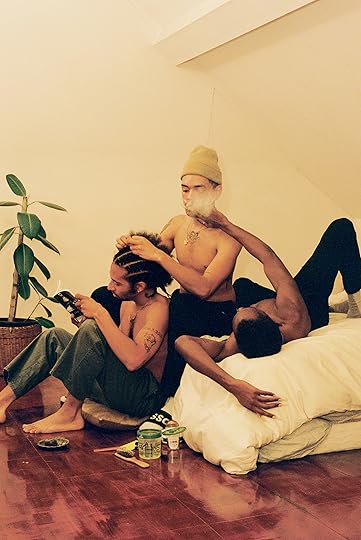
Clifford Prince King, Safe Space, 2020
Courtesy the artist
In Safe Space (2020), King almost melds into a single entity with his two friends as they sit on a bed, entwined between one another’s legs, creating a wordless trust, harmony, and a physical closeness. One’s eye can’t avoid the opened canister of Eco Gel that lies at their feet, ready to lay King’s edges. As a true piece of Black ephemera and the expression of our hair traditions, the gesture represents an intersection of Blackness and queerness that is pivotal to King’s vision.
Slightly out of focus and raw, these photographs document ineffable moments of intimacy. It’s why King’s photo sessions are simply dubbed “hanging out.” Inviting his community over to his home in the West Adams neighborhood of Los Angeles, King prepares dinner or pours a glass of wine, creating an environment of quiet repose before lifting the camera to his eye. His photography becomes about communion and belonging, rather than something forced. “Obviously I want people to feel good about themselves if they’re photographed, but the point isn’t body or beauty, it’s more just about the presence of them being their real selves.” Settings aren’t necessarily pristine. Beds that his subjects curl up on go unmade; jeans that they wear appear stained and distressed; rooms they occupy are unadorned.
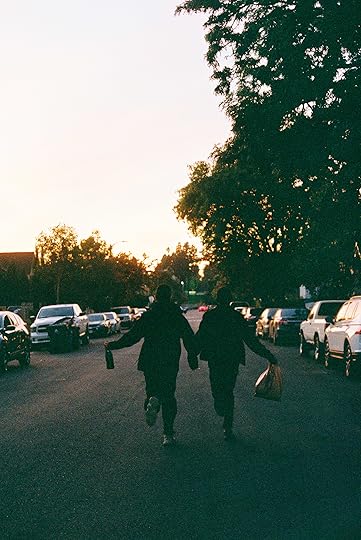
Clifford Prince King, Run Along Home, 2020
Courtesy the artist
You can’t attach a particular historical moment to Run Along Home (2020), an image of mad abandon, one that evokes not only the Southern adage of getting home before the “streetlights turn on,” but also the joy of escaping to one’s home and being alone with a lover. And that is King’s objective. He is focused on creating work that he hopes can be discussed years from now, and in this way, his photography is in conversation with those artists he counts among his inspirations and friends: Deana Lawson, D’Angelo Lovell Williams, Paul Mpagi Sepuya, Black contemporary photographers who are putting Black intimacies at the forefront for a lasting effect. King acknowledges that their work is much more intentional than his. But for now, he’s proving the soft power of the everyday.
Marjon Carlos is a journalist and editor living in New York and a contributor to publications including Essence, Vanity Fair, and Vogue. She is currently working on her first book, a memoir.
Read more from Aperture, issue 239, “Ballads,” or subscribe to Aperture and never miss an issue.
June 16, 2020
The Original Ballad
How did Nan Goldin’s slideshow with hundreds of images, presented at bars and nightclubs, become an iconic photobook? Elle Pérez speaks with Marvin Heiferman about the making of The Ballad of Sexual Dependency.

Cover of the original maquette of The Ballad of Sexual Dependency, ca. 1985
Courtesy Nan Goldin
Elle Pérez: I teach The Ballad every semester. And I create this fake slideshow for my students. I’ve scanned the entirety of the book. We put it up on the screen, and we play it in the dark, and I use a playlist for the music.
Marvin Heiferman: Oh, you kind of re-create it. That’s hilarious.
Pérez: It goes from Maria Callas to James Brown, and then—what’s that one song that’s like, “Kiss the girl” … ?
Heiferman: “Miss the Girl.”
Pérez: Yes. So we sit there for forty-five minutes and watch it.
Heiferman: The Ballad as a slideshow is so different from the experience of The Ballad as a book. Part of it is the power of the audio and the sort of trance state you get pulled into when you watch it, and listen to it.
Pérez: The color washes over you in such a different way than when you’re looking at it in the book. When it’s illuminated on a screen, you feel like you’re watching something that has to do with the sequence of the book, which is very romantic.
Heiferman: Romance is not a bad word to use. That’s certainly part of the allure of The Ballad. I don’t look at the book all that often, because I know it all too well. But looking at this new edition, it’s truer to the color and the experience of Nan’s slides in terms of that richness, which has a lot to do with what it takes to move people through The Ballad as a slideshow and as a book.
Pérez: How did you get involved in working with Nan? How did you even meet?
Heiferman: I was working at Castelli Graphics and running the photography program there. On the one hand, I was working with people like Lewis Baltz, Robert Adams, John Gossage, Ralph Gibson, and Mary Ellen Mark. And on the other, I was continually trying to open up the program and look at different ways photography functioned. I worked on Ed Ruscha shows, Andy Warhol shows, and Robert Rauschenberg shows. Marian Goodman’s print publishing business and gallery, Multiples, was around the corner, so I got to meet people like John Baldessari. My boyfriend at the time was in the Whitney Independent Study Program, and through him I met the whole Pictures Generation crowd. I was lucky enough to beat Castelli when multiple image worlds were kind of colliding with one another: modernist photography, the artist-using-photography thing, the Pictures thing, the rise of conceptual photography. Even though the gallery represented a specific group of people, I kept looking at work and kept trying to bridge all those perspectives in many of the projects I did.
One day, I think it was in 1978, I got a phone call from a person who said, “Joel Meyerowitz told me to call you up and show you my work.” It was Nan, and she was still living in Boston. So we made a date, and when the time came, Nan walked up the dramatic red-carpeted spiral staircase in the Upper East Side brownstone where the Castelli Gallery was located with a box of about twenty-five prints under her arm. They were fucked-up prints, with weird and oversaturated color, kind of messy prints, and some were signed “Nancy Goldin” in tiny, tiny handwriting. I looked at them, and I thought they were fantastic. I could tell what she was doing right off the bat, knew nobody else was doing anything like it, and I said, “Bring some more stuff back.”
When she showed up again, it was with a crate full of pictures, scores of them, which we went through. They confirmed to me that what Nan was up to was phenomenal. There was nothing like it. It was clear as day.

Spread from the original maquette of The Ballad of Sexual Dependency, ca. 1985
Courtesy Nan Goldin
Pérez: What did you see?
Heiferman: Pictures about relationships. This was a time when color photography was just starting to gain credibility in some people’s minds—and here were these pictures that looked and felt much more intense than anything that anybody else was doing. Even though Larry Clark’s Tulsa (1971) was already out in the world, Nan’s work looked explosive, too, but different. The pictures were just full of emotion, full of color, full of love. What struck me was what an incredible picture maker she was, which often doesn’t get talked about.
Pérez: I totally agree. I’ve looked at them many, many times. The one of Cookie Mueller sitting at Tin Pan Alley [Cookie at Tin Pan Alley, New York City, 1983] is an incredibly well-constructed photograph.
Heiferman: Yes, and while the pictures were individually beautiful in a particular way, it was their cumulative impact that was overwhelming. Nobody was making that kind of work about people in complex, intimate relationships. Nobody was making those pictures about sex who wasn’t glamorizing or pathologizing it.
The work was clearly unique, so I said, “Okay, let’s try to do something with this.”
I wanted to do a show of Nan’s work, but the gallery didn’t want me to do it. Basically, Mrs. Castelli said she thought that Ellsworth Kelly would be horrified by the pictures. (I’m sure Ellsworth would have loved them.) Basically, I think she was afraid of them. And it was that kind of resistance that was a contributing factor to my leaving the gallery.
After I did, I worked with Nan from about 1981 until about 1988 or so, and during that period I helped get the work out into the world. By that time, I had a lot of contacts in the art and photography communities and kept showing people the work and raving about it. Around this time, Nan started to develop the slideshow format, and soon The Ballad began to evolve. It was different every time Nan showed it.
Pérez: You helped produce the slideshows?
Heiferman: Yes, we both worked to line up venues to show it, and I was around when she was editing the slideshow some of the time. That was an extraordinary part of the experience, because while photographers so often work toward distilling a concise body of work, here we were dealing with this expansive, evolving, public, performative, dramatic thing. Some images were always included in the slideshows, but new ones were introduced all the time. Sometimes the chaos of the slideshow coming together—and often in the moments right before we had to throw carousel trays full of slides into bags, get in a cab, and show up someplace and present it—was unbelievable.

Spread from the original maquette of The Ballad of Sexual Dependency, ca. 1985
Courtesy Nan Goldin
Pérez: Where were you showing it?
Heiferman: We would show it at clubs and places like OP Screening Room, on Broadway, which no longer exists. There was a notorious showing at the Saint [a gay club in the East Village that was open from 1980 to 1988], which I thought was going to be the end of my life.
Pérez: What made it notorious?
Heiferman: Just keeping things on a schedule and showing up on time was always a challenge, and it almost didn’t happen that night. People don’t realize that before The Ballad got programmed, which was for the Whitney Biennial in 1985, it was different every time we showed up. And when we did, there would be just two projectors, side by side, the music would start, and Nan would clutch the remotes, one in each hand, and the show would begin.
Pérez: So she would run it.
Heiferman: Yes, and there could be glitches. Slides would get stuck. Projector bulbs would burn out. We had to switch out slide trays on cue and as seamlessly as possible. So every time, for me, was a little suspenseful. The Saint was amazing, because it was probably The Ballad’s biggest venue at that point. There were hundreds, a thousand, maybe more—I don’t know how many people were there. I thought we were never going to pull it off, that it was never going to happen. And then it did, and when it was over, the place exploded. What is still vivid in my mind is a bunch of us frantically sorting out slides on Nan’s light boxes in her loft on the Bowery, just blocks away from the club, still traying slides as the show was scheduled to begin. That was a very different experience from working on the book, which we laid out on the floor of my loft in the Garment District in a much calmer process.
Pérez: It went from hundreds of pictures to how many?
Heiferman: The book has 127. That was the big challenge. It was clear that Nan wanted to do a book and wanted it to be an Aperture book, because she had an appreciation for what they did, and she wanted to be part of that history. That kind of ambition was, I thought, terrific, but at that point Aperture had never done anything like The Ballad. For me, what I learned when I was working in the ’80s was that you’ve got to make your own opportunities. The way the photography world was set up at that time, it was stratified, conservative, and dominated largely by straight white guys. If you wanted to make friction or make a break, you had to figure out how to do it yourself.
But I knew I could, pretty easily, take the book project to Aperture because I knew a lot of people working there. I just wasn’t sure they’d bite. I think I showed it to Mark Holborn [an editor there] before I showed it to Michael Hoffman [the former director of Aperture], but when I showed the work to Michael and he said, “We’ll do it,” I thought, Whoa. Whoa, we did that.
Pérez: But then how did you actually do it?
Heiferman: We realized we had to stick to the sequence that the index of songs lays out, which drives the narrative of the piece forward. But first we’d have to edit The Ballad down, get rid of what, six hundred pictures, 550 pictures. If you’re always shooting people in bed, you’re going to have two hundred pictures of people in bed. If you’re always looking in mirrors, there are going to be two hundred pictures of people looking in mirrors. And then, there were always the favorite pictures, the pictures that worked best and, on their own, that created their own worlds, that had their own integrity.
Pictures were spread out on the floor of my loft for a long time. Weeks maybe. Me and Nan, and Mark Holborn, some of the time, and Suzanne Fletcher, some of the time. Sequencing books is very much like making music. The goal is to make things flow, to get somebody both to look and to turn a page. That was the challenge—to get rid of the extraneous stuff, keep the pictures we couldn’t live without, and then keep cutting from there.
Pérez: Were there a few that became the anchor points for the book?
Heiferman: The cover picture. The picture of Nan’s face battered. Some of the sex pictures. The drug pictures. The party pictures. Everybody’s got their own favorites. The Hug (1980) is one of mine.
When I was looking through the book earlier today, something I was struck by, and I’m sure we were conscious of, is the way the book moves from horizontal pictures to vertical pictures, from indoors to outdoors. There’s also the relationship between people looking at the camera versus people looking off to the sides of the frames, which Nan does consistently enough that it becomes an element in sequencing, too. You’re being directed. There’s the narrative. It’s like: Who are these people? What’s happening to them? What’s their relationship to one another? There’s the lush color that runs through the book. There’s the emotional roller coaster that takes you from pictures at parties and of people laughing, to pictures of people crying, and that hooks you. People have called The Ballad “operatic” and for good reason, because its grand scale and expressiveness sweep you along with it.
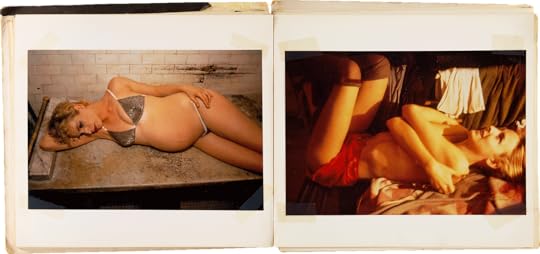
Spread from the original maquette of The Ballad of Sexual Dependency, ca. 1985
Courtesy Nan Goldin
Pérez: Did you know it was going to be an important work?
Heiferman: Yeah. But it took ten years of convincing people. Because photography was still a confusing thing to people.
Pérez: It’s still this confusing thing to many people. It seems a little more accepted now, but I feel like people are still not sure to this day.
Heiferman: We’re still having that conversation, which is ridiculous to us.
Pérez: But we’re in.
Heiferman: Right, we’re in.
When we made the book, one of the challenges was getting model releases from people, which was dicey at times. I remember when Aperture asked, “Do you have model releases for everyone?” and I said, “No.” Something else I remember vividly is going down to the East Village to try to get hold of Brian, Nan’s ex, and get him to sign one and standing on the street, screaming up to his window, trying to cajole him to come down so I could give him a model release to sign—which never happened.
Pérez: And what about the text for the book?
Heiferman: The text that Nan wrote was the only text in the book. It didn’t dawn on us to go get somebody to write an essay for this book, to try to explain this book to the world. The difference between Nan’s text and the kind of postscript text in the back of the recent edition is interesting to see, too. It underscores that Nan always knew what she was doing.
Pérez: She writes, “I don’t ever want to lose the real memory of anyone again.” There is something about that “real memory” that is related to how visceral the book is.
Heiferman: The work’s intensity and authenticity were, and still are, palpable. It’s interesting now, in an Instagram world where everybody is projecting and branding themselves and figuring out how to represent themselves, that what Nan was doing was representing, but with a different set of criteria, a different set of brackets, a different kind of goal in mind.
Pérez: Totally. I think people in general are struggling with the claim that the camera can take control over a person’s own image. But, then, simultaneously, there’s a paradox, where people are very nervous now to use the camera to stake a claim.
Heiferman: You’ve got to take responsibility for yourself, the way you see yourself, and the way you see the world. That’s a tantalizing and scary thing, but that’s what identifies people as artists. Right?
Pérez: That’s a pull quote right there.
Heiferman: You want to see the world through somebody else’s mind or eyes, and Nan lets you do just that. It’s not that she wasn’t influenced by work that came before her. She was, and she knows it, and she has said it—and who wouldn’t be? Nan studied photography enough to know stuff. But what came out was something else.
The process of shooting all the time, which Nan did back then, gave her the option of constantly reediting the work and changing it. The kind of fluidity that the work documents, just on a process level, is also what it represents in terms of people’s lives—the fluidity of those lives. That’s another reason why the slideshow format was kind of perfect. And what makes the book so different is that it freezes The Ballad because people have such respect for and have put so much faith in books, where they experience pictures differently and privately. There was not a lot of opportunity to see The Ballad unless you were in New York, Berlin, Paris, or wherever it played. And there’s still not much opportunity to see it, because it’s such a big deal to mount it and dedicate viewing space to it. Back then, what was extraordinary was the experience of the slideshow, of seeing it in a club where everybody’s drunk and stoned, or at least lots of them are, and a good number of them are also in the pictures and are screaming when they see themselves on-screen.
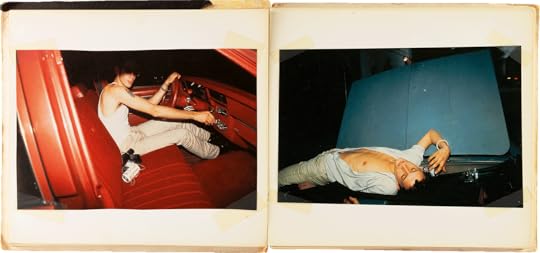
Spread from the original maquette of The Ballad of Sexual Dependency, ca. 1985
Courtesy Nan Goldin
Pérez: That’s amazing.
Heiferman: There’s also the difference of seeing a version of The Ballad when it’s the actual slides that are being projected, when you hear the clunking sound of them advancing in an irregular rhythm against the beats in the music, versus the experience of the digitized, smoother, synched-up versions where everything runs smoothly. No matter what, though, The Ballad works. Every time you see it, it’s different, because there’s so much to process and take in. And, for me, watching it is still a very personal thing, I just tear up. I remember all the stuff that went into it, my closeness to it, and, of course,
I can’t escape the theme of loss—that plays such a big role in it.
Pérez: That’s why I put such an emphasis on actually showing my ghetto version of the slideshow to my students. There’s something about the participation of it, too.
People always have these fantasies of bohemias, art worlds, and these communities of people. In fact, people create their own communities to support the work they’re doing—and here people got to see it celebrated in this kind of glamorous way.
Heiferman: That’s another quality of the work that’s wild. It is, in its own way, glamorous. You get to see this subculture that, for want of a better term, got turned into something cinematic. It’s a word that people tend to use a lot, but in this case the work really is. Nan always said she wanted to be a filmmaker, and I think that was always in her mind; she was always taking so many pictures. It was kind of like [Eadweard] Muybridge. She was both living life and capturing it in stop-motion.
Pérez: The other thing I’m thinking about right now is the relationship of this book to a book like The Americans (1958). That was something like twenty thousand photographs edited down to eighty-three pictures—how do you even reduce that? The Ballad went from some unknown number of photographs to eight hundred pictures. How many pictures do you need to make eight hundred good pictures? And then, to bring that down to 127. They’re both epics, in a way.
Heiferman: Look at Robert Frank and his move to video. Nan has made videos, too. I think there’s this recognition of both the power of individual images or images in a group, and the limitations of them.
Anybody who is making images a lot, and seriously, is going to grapple with that.
Pérez: When I first started making pictures, they were for all the punks up in the Bronx. I would put them up online, and then everybody the next day would look, and I would get immediate feedback. There’s something in the validation of showing things to your community first.
Heiferman: But then to be able to come up with work and narratives that reach beyond that audience is the interesting thing. As you were talking about putting stuff up online, I just kept thinking about Instagram. People’s Instagram feeds are their versions of The Ballad. How many pictures do you tell your story in? It’s an ever-evolving process. There’s a self-consciousness to that and, as The Ballad proved, a good reason to rely on photography to figure out who you’ve been and who you are going to be.
Elle Pérez is an artist based in New York. They are a visiting assistant professor in Harvard University’s Department of Art, Film, and Visual Studies and a dean at the Skowhegan School of Painting and Sculpture.
Marvin Heiferman is an editor and writer based in New York and the author, most recently, of Seeing Science: How Photography Reveals the Universe (Aperture, 2019).
Read more from Aperture, issue 239, “Ballads,” or subscribe to Aperture and never miss an issue.
June 11, 2020
Why Photo Editors Need to Hire Black Photographers Every Day
And not only during a crisis.
By Will Matsuda

Wale Agboola, The Uprising, Minneapolis, 2020
Courtesy the artist
When New York Magazine chose a white conflict photographer’s image for the cover of their June 8, 2020, issue, there was an uproar on Instagram. The magazine’s outspoken (white) art critic Jerry Saltz called the cover “tremendous.” But Lindsay Peoples Wagner, editor in chief at Teen Vogue, commented, “sad that you hardly ever hire black photographers to shoot covers and STILL didn’t this week of all weeks.”
This was not an isolated incident. National Geographic and Vanity Fair both hired prominent white photographers for protest coverage, demonstrating the systemic issue of whiteness throughout the photography industry. When a Google spreadsheet of Black photographers was circulating widely, why would photo editors make this choice?
As Danielle Scruggs, a Chicago-based photo editor at Vox and board member at Authority Collective, told me, “The whole reason why there is so much racism, sexism, ageism, classism in the industry is because all of that exists in society.” Non-profits, media outlets, museums, and photography schools attempt to alleviate this contradiction by elevating “diverse” photographers, giving them grants or putting them on diversity panels. But who actually benefits from those panels? How does a grant or scholarship fix a systemic failure? And who benefits from highlighting Black photographers only during a time of crisis?
I recently spoke with Scruggs and three other Black photo editors and photographers about covering this moment and what needs to change: Lynsey Weatherspoon, a photographer based in Atlanta; Wale Agboola, a photographer based in Minneapolis; and Brent Lewis, photo editor at the New York Times and cofounder of Diversify Photo. They talked about the inherent subjectivity of photojournalism, the racist distribution of power and opportunity in the industry, and their demands for a sustained commitment to make photography more Black, far into the future.

Wale Agboola, State Capital, Minneapolis, 2020
Courtesy the artist
Will Matsuda: Why are you choosing to photograph the protests?
Wale Agboola: As Black people, we have to be able to tell the stories how we want. After I found out about George Floyd’s death, I couldn’t sleep. At 2 a.m., I walked down to Cup Foods [the site of George Floyd’s murder] to see what was happening. When I got there, I broke down. A friend of mine told me that I had to get to the Third Precinct right now. “Everything is on fire,” he said.
So I went and saw Black pain. Fear. People who were angry. They wanted answers. I wanted to do my best and tell the story the way I see it. The way I’m feeling that pain. When I saw the video of George Floyd, I lost a side of me that was peaceful. It turned into anger. I channeled that feeling into my photos.
Lynsey Weatherspoon: I’m originally from Birmingham, Alabama, one of the epicenters of the Civil Rights Movement. I needed to see what was going on, and I needed to walk in solidarity. Photographers have different voices, and I wanted mine to be heard.
Matsuda: What do you think about the current conversation about who should photograph these protests?
Danielle Scruggs: I’m glad we are having these conversations in a really explicit industry-wide way. Sometimes, it feels like I’ve been screaming into the void [laughs]. We need to hire more Black photographers. We need to hire more Black photo editors. Not only to cover things like protests and uprisings, and things that only pertain to Black communities. We need more Black photographers doing food stories. More Black photographers doing culture stories and fashion stories. It shouldn’t be just for hard news; it should be for everything. It should be across the board.
It shouldn’t be a scramble for people to hire Black photographers and photo editors. That should be something ingrained in this industry, and it’s not. There’s especially a problem with how overwhelmingly white leadership positions are in the industry. If you only see predominantly white men crafting visual narratives about everything, that becomes a really big problem. It works right now if you believe in systemic inequality.

Wale Agboola, The Clean Up, Minneapolis, 2020
Courtesy the artist
Matsuda: It works how it was designed to work.
Scruggs: Yeah, exactly. That’s why I’m over discussions of reform in journalism, but especially in visual journalism. There needs to be a much bigger conversation about who is crafting those images. Why those images are being crafted. Why certain visual tropes come up. Why certain people have been completely shut out of this industry for decades.
Agboola: At George Floyd’s memorial service, every person doing video was white. A bunch of foreign press was in town. This guy came up to me that looked like he was from a very reputable news station and said, “Hey, who is the dude with the family’s lawyer?” The person he was talking about was Reverend Al Sharpton. If you don’t know who that is, you should not be here. It was such an insult.
Looking around and not seeing very many Black photographers felt very disappointing, because the stories weren’t going to come from the right place. It breaks my heart. I see things through the pain I’m feeling. I put that into my work. I have to make sure when I am shooting to not lose myself. I want an imprint of myself in the photo. To make sure that what I am feeling is conveyed. It is a lot of pain. I haven’t been able to take a breath and cope yet.

Wale Agboola, Protest at Minneapolis Third Police Precinct, Minneapolis, 2020
Courtesy the artist
Matsuda: What would you say to non-Black photographers covering this moment?
Brent Lewis: Well, I do think there should be non-Black photographers out there. Black photographers should lead the way, though. It comes down to understanding. Non-Black photographers should be more empathetic. Have conversations and ask why people are out there. People are protesting to have their voices heard. Don’t just point a camera in someone’s face. I’ve heard some photographers are asking for permission at the protests. If it’s a safe moment, have that conversation. It opens up a dialogue. Even to the Black photographers out there, I would say ask those same questions.
One summer back in Chicago, I was taking pictures of these kids playing in this opened fire hydrant. One of them turned to me and said, “Did somebody die?” The only time they see journalists coming into their neighborhood is when someone gets shot. The media shows up when things are on fire. If people actually cared about the Black experience beforehand, we probably wouldn’t be in this position. It wouldn’t feel so invasive either.
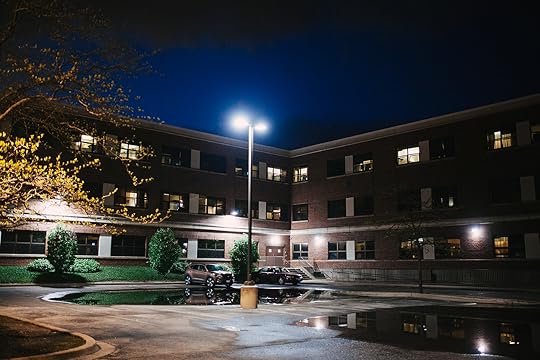
Danielle Scruggs, The Villa at Windsor Park Nursing Home on the South Side of Chicago, 2020
Courtesy the artist for the New York Times
Matsuda: A common refrain I’ve been hearing from non-Black photographers is that they think pictures are objective—they are just photographing what is in front of them. So why does it matter who is taking the picture?
Weatherspoon: Whatever situation I put myself in, I put my full identity in it. That’s being Black. That’s being queer. That’s being a woman. So that all goes into whatever story I’m photographing. If you come to a story from only a gender perspective or a race perspective, it causes mistrust with the people you photograph. Black people are at the center of so much history, but you rarely see Black people, let alone Black women, who are allowed to cover these stories. You have to bring your full identity, your full self, to whatever shoot you’re doing. But you’ll have biases in what you see no matter what.
Scruggs: Objectivity doesn’t exist. You bring all of your lived experiences into whatever you’re doing, whether that’s picking up a pen or a camera. All of your lived experiences affect what you put in a frame and what you keep out of it. What stories you choose to tell and what stories you choose not to tell. The best that we can do is aim to be fair. Tell as complete a story as we can. But objectivity is not a thing. It’s a way for people to hide. It’s a way to avoid having those uncomfortable conversations.
Matsuda: How are you maintaining the energy and strength to keep making these images?
Agboola: I’m not. Today [June 6] is the first day I am taking for myself and not picking up my camera. Today, I want to breathe. Today, I want to acknowledge where I am at emotionally. I haven’t slept this week. I wake up in the middle of the night with sleep paralysis.
In Minneapolis, there have been white supremacists riding around in the middle of the night. Every time I would go outside and hear a loud truck, I ran into the bushes. I couldn’t breathe this week. I was in pain. I couldn’t even feel safe in my home.
Today is the first day where I can assess myself. I need to talk to my therapist. It’s been hard, man, I’m not going to lie. But it’s also been great to see the way Minneapolis has come together in a ridiculous, iconic way. After buildings burnt down, people were out the next morning cleaning it up with shovels and gloves, in the middle of a pandemic. Allowing the anger to go on. They did not even question it. It got me emotional. It was beautiful.

Danielle Scruggs, Travis Johnson, an attendee at the American Descendants of Slavery conference in Louisville, Kentucky, October, 2019
Courtesy the artist for the New York Times
Matsuda: How can photo editors do better?
Weatherspoon: I’m seeing an influx of attention—they want to see more of our work. In a way, it’s a little concerning. Why now? We have been doing this for so long. Why is it now that you want to hear our voices? We have been photographing our joys, our pains, our questions, our everything. You didn’t listen. I question the motive of those who are reaching out to us now.
Matsuda: This interview right now is part of that complex, no doubt.
Weatherspoon: Yeah, let’s be real about that. I hope media outlets, brands, agencies, and galleries understand that we’ve always been out here. People are now starting to catch up on what we’ve been doing. If you decide to hire a Black photographer, make sure you continuously hire them. Don’t give us that line, “We look forward to working with you in the future.” Make it count. None of us are going to be in this for a long time. I can tell you right now. I don’t want to do this for the rest of my life. I do enjoy it, but when it’s my time to sit down, I want to continuously see Black people thriving in this field. Not just now. There’s no excuse for not hiring a Black photographer for any type of story now. Why does it take someone being murdered for us to show our work?
Scruggs: Photo editors need to change who they view as experts. Change who they deem as worthy of getting an assignment to. Just because you aren’t as familiar with someone doesn’t mean that they are not capable of executing an assignment in an accurate and compelling way. There also needs to be a fundamental shift in how photo editors view their jobs. You can’t stop at, “Well this person doesn’t have a lot of experience, so I’m going to go with this white man, because he has twenty years of experience.” Why was that white man given all those opportunities to get twenty years of experience in the first place? You have to be willing to mentor people, and train people, and see that they are getting paid fairly, which is a huge issue in this industry.
I’ve always worked simultaneously between being a photo editor and a freelance photographer. I know firsthand what it is like to front money for travel for an assignment, and then you have to wait three months to get paid back for that expense. If you’re not independently wealthy, how do you make that happen?
What are you doing to make sure freelancers are safe, and paid on time and fairly? Give them the resources and support so they can end up with twenty years of experience.

Lynsey Weatherspoon, A young woman raises her fist in the middle of the street on the first day of the protests, May 29, 2020
Courtesy the artist
Lewis: I understand things are moving quickly, but I need photo editors to understand that people are protesting four hundred years of history. I am happy to see so many people hiring Black. But don’t hire a Black photographer and say, “Alright, I hired my one Black photographer!”
We have been disadvantaged. Many Black photographers didn’t go to all these workshops or legacy photojournalism schools. They’re just damn good photographers. But many of them don’t know the process, because photo editors have never thought to teach them. Or ask them. Things like FTP transfers, captions, or metadata. Take a second and ask if they have questions about what they need to do. Make sure they read through and understand the documents. Ask if there is something they don’t know. When I was coming up, I wouldn’t ask a damn thing.
It takes a little bit longer for photo editors to do that work, but it pays off. Your workflow becomes better. I’ve let myself down by not asking these questions. It has resulted in unnecessary back-and-forth email conversions and texts, or me writing captions when I was on a deadline. All that would have been alleviated if I said, “Hey, you’ve never worked for the New York Times before. Let’s talk everything through while you’re filing. About what you need to do.” That goes so far. These are skills that photographers can take away. Money is cool, but don’t forget about skills that they can take elsewhere. Photo editors need to do that legwork. Especially right now, when so many photographers are getting their first looks. Organizations like Authority Collective and Diversify Photo have been saying this for years. But you can pick it up right now. Teach.
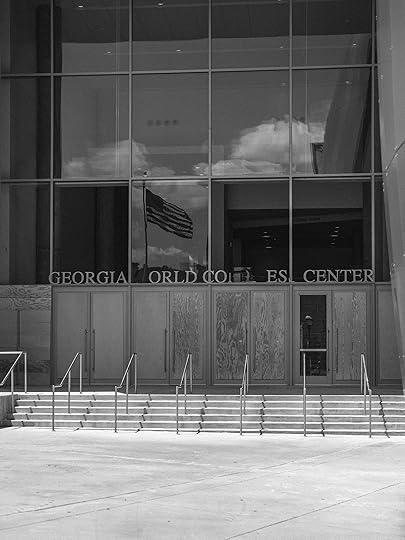
Lynsey Weatherspoon, Sunday morning after two nights of protests in downtown Atlanta. The American flag waves in the window of the Georgia World Congress Center, 2020
Courtesy the artist
Matsuda: I’ve been spending a lot of time with the work of Angela Davis these past few weeks, and she stresses the importance of critiquing racism and capitalism at the same time. While I agree that we need more Black photographers and photo editors, I am also thinking about how many Black people can’t even afford to get into the industry in the first place because of racial capitalism—to even be part of a shared Google doc of Black photographers. How do we address this structural exclusion?
Scruggs: I’m glad you brought that up, because hiring Black photographers solves only part of the issue. We have to look at this from a systemic level. You can’t redline people and put them in neighborhoods with no resources, no schools, no mental health resources, no grocery stores, no generational wealth, and then compare them to their white counterparts, and tell them to go spend $2,000 on digital camera body, another $2,000 on a laptop, and another $1,300 on lenses. All of that when there is no potable water in the neighborhood either. How do you afford all that to even get started in the industry as a photographer?
The databases [of Black photographers] are great resources, but the problem isn’t just that people didn’t know that there were Black photographers. It’s a good start, but it’s not the full solution. The people in power—people at the leadership level, the publisher level, the corporate level—don’t see us and I don’t think they care. When I say, hire Black photographers, it’s only part of it. Think about how to work in a collaborative way, rather than just an extractive way. Consider the toll that it takes on Black people’s mental health. We need to think about how to really bring people in and make them feel welcome.
Weatherspoon: Economic disparities are certainly a weight on Black photographers since we’re historically denied credit or any funding that would accelerate our business goals. This would make anyone feel defeated, especially when you have White photographers who find you inferior because of what you lack economically. Black creatives are trying to keep up with the world, while trying to find ways to fund our career goals.
As for hiring Black photo editors, it is crucial that we know a job like this exists for us in the first place. Even if you decide to not be a photographer, we have to know that jobs like this exist in newsrooms, publications, and creative spaces.

Lynsey Weatherspoon, Officers stand in front of the Georgia State Capitol, 2020
Courtesy the artist
Matsuda: I worry that everything that brands and outlets are doing right now is performative. That there’s a lot of attention now, but what about next month? What does the photography industry need to learn from this moment? What does that look like in the long run?
Scruggs: It requires a fundamental shift in society. The whole reason why there is so much racism, sexism, ageism, classism in the industry is because all of that exists in society. White people especially, but also non-Black people of color need to educate themselves in being anti-racist. Really do that work and don’t ask Black people to hold their hands through it. We’ve been doing that and it’s really exhausting. We need that time to ourselves.
It’s been years, decades, centuries. Photography started out as a tool of white supremacy, and people don’t talk about that. One of the main functions of it was to reinforce slavery and colonialism. I wonder how you use a tool originally created for white supremacy to work against white supremacy? That’s a question that all photographers should be asking themselves, not just Black photographers. Specifically, white people need to have these conversations with other white people. Do not turn to your Black friend. They are probably not even your Black friend—they are your coworker. Don’t say, “How can I help? What can I do?” You need to turn to your white friends and say, “What do we do? Why don’t we know these things? Why have we been avoiding these conversations?” Don’t have a diversity panel. Literally, just hire Black people and people of color.
Lewis: Everyone’s hoping they won’t get dragged. That’s a fact. Sorry, not sorry. The goal is to level the playing field, and to do that we need new voices in here. Not just photographers, but editors, and directors of photography. The biggest takeaway for this in the long term is building relationships. Photo editors reply to people they know faster than to people they don’t know. These relationships are important. Build those relationships. A lot of photographers aren’t going to go to workshops or portfolio reviews or legacy photojournalism schools. But they are damn good. Knock down the whole gatekeeping thing. Open up the gates.

Lynsey Weatherspoon, Young man raises his hands during a protest in front of the Georgia State Capitol, 2020
Courtesy the artist
Matsuda: What do you need right now?
Scruggs: Wow, a lot of people don’t really ask that. I would say space. Giving people space to process. There’s a lot going on. Understatement of the year. Give people space to rest, process, be angry, and be sad. I need to have space to feel what I need to feel. I need concrete resources. Mentorships. Money. Fair pay. Historically, Black women are asked to do a lot and shoulder a lot. So I need a real investment. Cash dollars. There was a spreadsheet going around with what people were making in the industry. With only two or three years of experience, people are making three or four times what I’m making. So I need fair pay. Wages. Cash.
Lewis: I need people to care. Don’t do it for likes. Don’t just black out your Instagram. Read. Realize this didn’t start with George Floyd. It goes back four hundred years. Listen to podcasts. Take in everything you can right now. Understand why people are protesting in the middle of a pandemic. That’s how serious it is! People are like, “I’m more likely to die from police violence than I am from a pandemic.” That’s something you need to understand. I need you to look at yourself. You’re stuck in the house. You’re not going anywhere. This is the time to do it!
Weatherspoon: I need sunlight. I need for this bullshit to end. I need people to understand that this issue is not new; it’s always been here. Hopefully we get it right this time. I know we say that every time. We know names like George Floyd, Breonna Taylor, Ahmaud Arbery, Tony McDade, but how many countless names do we not know?
Agboola: Those four officers [responsible for killing George Floyd] need to be charged. There needs to be justice. For me, I need that. All those buildings that burned can be rebuilt; money can be remade. George Floyd is not coming back. As a Black man, I fear for my safety every day. When I get pulled over by police, my body turns into fear and I wonder if this is the end. So as a Black person, that is traumatic. I am dealing with that trauma. You have to listen to Black people. Black lives matter. If there is a protest tomorrow, I will be there. But I want to come home.
Will Matsuda is a photographer and writer based in Portland, Oregon.
Black Is Beautiful
In the 1960s, Kwame Brathwaite’s fashion photographs sent a riveting message about Black culture and freedom.
By Tanisha C. Ford

Kwame Brathwaite, Nomsa Brath wearing earrings by Carolee Prince, ca. 1964
Courtesy the artist and Philip Martin Gallery, Los Angeles
Everyone knows the phrase “Black is beautiful,” but very few have heard of the man who helped to popularize it. Brooklyn-born black photographer Kwame Brathwaite has lived most of his life behind the camera, devoted to capturing the lives of others on film. Spending much of the 1960s in his tiny darkroom in Harlem, he perfected a processing technique that made black skin pop in a photograph, with a life and energy as complex as that decade. Known by friends and comrades as the “Keeper of the Images,” Brathwaite has logged thousands of hours in the darkroom, dipping his fingers into harsh developing chemicals so often over the decades that the grooves of his fingertips have become worn. His labor reflects his deep commitment to black freedom and radical cultural production. With every dip, measurement of solution, and timing of exposure, Brathwaite styles blackness. His images, carefully calibrated to reflect a moment precisely, made black beautiful for those who lived in the 1960s, and continue to do so for a generation today who might only now be discovering his work.
I first stumbled upon Brathwaite’s photographs in 2009 at the Schomburg Center for Research in Black Culture in Harlem. There I found a series of provocative images of black picketers taken at an August 1963 protest of a white-owned beauty supply store in Harlem called Wigs Parisian. The black women and men in the photographs carry placards that boldly declare: “We Don’t Want Any Congo Blondes!” and “He’s Got Straight Hair, but He’s Still an Ape!” Drawings of dark-complexioned women with large lips sporting blonde wigs and an ape with slicked hair dressed in a tuxedo accompany the texts. The photographs are riveting and unlike any that I had previously associated with the protests of the early 1960s, when slogans such as “Freedom now” and “One man, one vote” were rallying cries. They touch a sensitive nerve. They confront our collective feelings of pain and shame. Those feelings about our hair and bodies that we adopted in childhood and still fight to keep at bay. These piercing images, locked away in a small box in Harlem, represent a history that I had never learned in college or graduate school. I wanted to know: Who was this photographer? Who were these protestors? Google searches yielded little; Brathwaite seemed to exist only in the photography of the past and in minor quotes in black nationalist publications such as Muhammad Speaks and the Liberator. My countless email requests for an interview with Brathwaite went unanswered, until I was able to speak with him last winter for this article.

Kwame Brathwaite, Naturally ’68 photo shoot in the Apollo Theater featuring Grandassa models and AJASS founding members (except the photographer). Center from left: Frank Adu, Elombe Brath, and Ernest Baxter, 1968
Courtesy the artist and Philip Martin Gallery, Los Angeles
Brathwaite found photography through his love of the rollicking rhythms of hard bop jazz. In 1956, he and his teenaged friends, all recent graduates of the School of Industrial Art (now the High School of Art and Design) in Manhattan, formed the African Jazz-Art Society and Studios (AJASS), a radical collective of playwrights, graphic artists, dancers, and fashion designers. Jazz societies were common at this time, and AJASS modeled itself after the well-established Modern Jazz Society. They opted to use the then much less common word African, which made their group distinct and referenced their political leanings.
Years earlier, Brathwaite and his older brother Elombe Brath, a graphic artist, had heard activist Carlos Cooks espousing the politics of black nationalist leader Marcus Garvey: “Take back our land!” “Go back to Africa!” “Black is beautiful!” His message of black empowerment and economic independence resonated with the brothers, and they joined Cooks’s African Nationalist Pioneer Movement. “We weren’t fond of just being colored folks, being under the yoke of anybody else,” Brathwaite told me when I interviewed him. AJASS members were the “woke” set of their generation, calling themselves African and black when most people were still using the now passé colored or negro. In jazz, they found a similarly rebellious spirit, a music that communicated emotions that could not otherwise be articulated.

Kwame Brathwaite, Sikolo Brathwaite wearing a beaded headpiece by Carolee Prince, ca. 1967
Courtesy the artist and Philip Martin Gallery, Los Angeles
AJASS members spent most of their weekends promoting concerts at the legendary Club 845 on Prospect Avenue in the Bronx, the epicenter of the borough’s jazz scene, where they began booking rising stars like John Coltrane, Lee Morgan, and Philly Joe Jones. “We could pick some of the best musicians in the world,” Brathwaite recalls. “We’d have good, packed houses all the time.” One evening in 1956 Brathwaite strolled into the club, greeted customers perched at the bar, then headed toward the back of the venue and into the cavernous performance space, the sound intensifying as he neared the stage. One of his school friends was snapping pictures in the dimly lit club, and Brathwaite was astonished that he was not using a flash or any additional light source. Nothing. Brathwaite, the advertising-arts major who had never really worked with a camera, asked his friend, “How do you do that with no flash?” His friend’s professional camera and Kodak Tri-X film (the film that revolutionized photojournalism because of its speed and versatility) were far superior to the camera Brathwaite had received as a gift at graduation. “I couldn’t do what he was doing with that,” Brathwaite told me as he swatted the air in a dismissive gesture.
And just like that, Brathwaite was hooked. He used his earnings from the jazz shows to buy a professional camera and devoured every photography book he could find. Jazz set the rhythm for his photography, which became central to his artistic approach. “You want to get the feeling, the mood that you’re experiencing when they’re playing,” he explains. “That’s the thing. You want to capture that.” But translating the moody blue notes of jazz onto film is not a skill one can learn from a book; it is sensory knowledge that comes from an understanding of jazz culture—the syncopated rhythms, the elasticity of sound, the spirit of improvisation. The temperament of jazz is the lifeblood of Brathwaite’s work.

Kwame Brathwaite, A school for one of the many modeling groups that had begun to embrace natural hairstyles in the 1960s, ca. 1966
Courtesy the artist and Philip Martin Gallery, Los Angeles
The new camera became young Brathwaite’s closest companion, kept within reach so he could take a snap whenever something intriguing crossed his line of sight. Most of his early images were from the Club 845 sets: jazzmen on their horns, spectators enthralled by the music. He also photographed the quiet intimacy of the musicians’ lives. “I’d go to Coltrane’s house at times. He would be playing the soprano sax in his kitchen with his T-shirt on. I got some shots,” Brathwaite told me. As the unofficial photographer of New York’s annual Marcus Garvey Day celebration, he quickly learned that photography required fearlessness. During the parade, Brathwaite would bend and contort his lithe body, often throwing himself into the crowd in order to document the extravagance and pageantry of the lively event.
As Brathwaite perfected his camera skills, taking hundreds of photographs each week in those early years, the movement for black freedom was erupting on the Harlem and Bronx streets around him, as much as it was in the American South. The federal government had overturned “separate but equal,” but black Americans like Brathwaite and his peers still felt the cold fear and unease of stepping too close to the invisible line of Jim Crow segregation. Photography was the insurgent technology through which everyday people and professional photojournalists alike captured the wild violence of police billy clubs and the quiet threat of “Whites only” signs in shop windows from downtown Manhattan to Montgomery, Alabama.
The “Black is beautiful” movement really started to coalesce in and around Harlem in late 1963, after the Wigs Parisian protest. “That’s when we started promoting ‘Black is beautiful’ even more. We had entertainment with fashion shows and concerts and stuff like that, which made us very popular in the community,” Brathwaite said. They began using “Black is beautiful” and other slogans such as “Think black” and “Buy black” on event flyers and other ephemera.
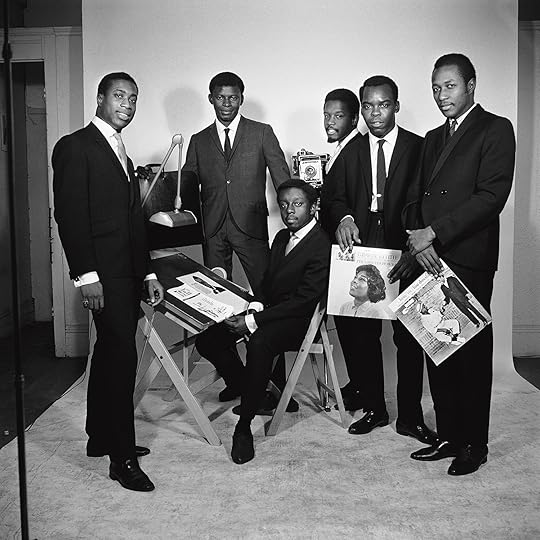
Kwame Brathwaite, AJASS members Robert Gumbs, Frank Adu, Elombe Brath, Kwame Brathwaite, David K. Ward, and Chris Acemendeces Hall, ca. 1961
Courtesy the artist and Philip Martin Gallery, Los Angeles
Brathwaite wore his “Keeper of the Images” title with great pride and conviction, allowing his brother to take the lead as the public voice of their movement. Yet, the mostly male group realized that beauty and body issues affected black women differently. “We said, ‘We’ve got to do something to make the women feel proud of their hair, proud of their blackness,’” Brathwaite explained to me. In order to truly communicate why black was inherently beautiful, they needed women at the helm. With the help of a well-connected AJASS member, Jimmy Abu, they began recruiting teenage and young adult women to model in a community-based fashion show. They named the group Grandassa, drawing from the word Grandassaland, which Carlos Cooks used to describe the African continent. The original models had deep chocolate skin, full lips and noses, and wore their hair in “natural” styles that highlighted their kinky textures.
The Grandassa models dazzled the crowd of mostly black folks from Harlem and the surrounding neighborhoods who assembled at the Purple Manor on January 28, 1962, for Naturally ’62: The Original African Coiffure and Fashion Extravaganza Designed to Restore Our Racial Pride and Standards. Actor Gus Williams served as host alongside jazz singer and activist Abbey Lincoln, while her husband, jazz drummer Max Roach, led the house band. The models sashayed across the makeshift catwalk in vibrant dresses, skirts, and sophisticated blouses constructed from fabrics with intricate prints. Each woman accessorized her look with large hoop earrings, chunky bracelets, and kitten-heeled mules and sandals.
The event was a smash. AJASS soon produced more shows, eventually making Naturally an annual event. “We started picking up designers, black fashion designers,” Brathwaite said, noting that Carolee Prince, who created headdresses for famed singer Nina Simone, also showcased her original pieces in the Naturally shows.

Kwame Brathwaite, Grandassa models after the Naturally fashion show, Rockland Palace, ca. 1968
Courtesy the artist and Philip Martin Gallery, Los Angeles
Brathwaite and his crew realized they were now at the center of a brewing national conversation on colorism and race pride within the black community. The Grandassa models were not simply countering the images of pale and frail British models such as Twiggy and Jean Shrimpton who appeared in mainstream U.S. publications. They were also challenging the ubiquitous presence of lighter-complexioned, straight-haired black models in black- owned publications such as Ebony. “There was lots of controversy because we were protesting how, in Ebony magazine, you couldn’t find an ebony girl,” Brathwaite told me.
Spurred on by the cultural zeitgeist of the moment, Brathwaite transformed AJASS from a band of creative teens into a group of businessmen and -women who could “sell” their vision of blackness to an international audience. In 1964, they signed a lease on a studio space next to the Apollo Theater. Brathwaite and Brath produced “Black is beautiful” ephemera—as well as several Blue Note Records album covers—and charged a sitting fee to photograph local women and men. Later, they operated a café-style meeting space called Grandassa Land, on Seventh Avenue between 135th and 136th Streets, where they hosted poetry nights and plays organized by the AJASS Repertory Theatre. Lincoln and Roach introduced them to club owners in the Midwest who invited AJASS to present Naturally shows in Chicago and Detroit. Images of the stylish Grandassa models appeared in black publications in the United States, Britain, Nigeria, and Rhodesia (now Zimbabwe).
The popularity of Grandassa and AJASS made Brathwaite a sought-after photographer for international magazines. His photographs of megastars such as Stevie Wonder, Muhammad Ali, and Sly Stone were published in Britain’s Ad Lib and Blues & Soul magazines, as well as in publications in Japan. With those early paychecks—much larger than the meager sitting fees he charged neighbors in Harlem—Brathwaite upgraded his equipment and traveled the world. He had encounters that a boy from the Bronx, whose only taste of the international had been his mother’s Caribbean coconut bread, could have only dreamed of.

Model inspired by the Grandassa photo shoot at AJASS, ca. 1965
Courtesy the artist and Philip Martin Gallery, Los Angeles
Naturally shows became less frequent as the 1960s drew to a close. Brathwaite and Brath delved deeper into pan-Africanist activism, and they traveled extensively across the African continent, working alongside activists in Ghana, Nigeria, Congo, Namibia, Tanzania, Kenya, Ethiopia, Sudan, and Egypt. Meanwhile, the catchy slogan “Black is beautiful” continued to spread and was used to sell everything from hair-care products and T-shirts to alcohol and cigarettes. The two brothers had helped to usher in this moment, making black nationalism artful and accessible to everyday black folks. But the brothers’ absence from the political, social, and artistic scene in the United States, and the ubiquity of soul music and black power imagery in the early 1970s, meant that most people never came to know them, AJASS, Grandassa, or the vibrant history of the second-wave Harlem Renaissance, of which they were at the center. Brathwaite’s photographs, which provide much-needed texture to our understanding of the black freedom movement, never became part of the movement’s visual canon. Instead, his images found a home in the Schomburg Center in Harlem, not far from where the AJASS studio was located, where they lay in wait for an eager researcher to access them and understand their significance. There were no retrospectives, no splashy write-ups.
And Brathwaite was fine with this. He never pursued photography for the accolades. He enjoyed the quiet life outside of the spotlight. Elombe Brath died in 2014, after suffering a series of debilitating strokes. The loss upended Brathwaite’s world. His brother was always the voice, the one who could galvanize the crowd with his booming speeches. With his passing, and that of most others in their collective, Brathwaite realized that he was not only the “Keeper of the Images”; he was now the keeper of the stories, too. If he didn’t share this history, it would be lost to time. At seventy-nine years old, Brathwaite is now telling the tale of how he—the son of West Indian immigrants—and a crew of black teens from the Bronx styled the world.
Tanisha C. Ford is author of Liberated Threads: Black Women, Style, and the Global Politics of Soul (2015).
This piece was originally published in Aperture, issue 228, “Elements of Style,” Fall 2017. See more of Brathwaite’s work in Black Is Beautiful (Aperture, 2019).
June 4, 2020
George Floyd, Gordon Parks, and the Ominous Power of Photographs
From the Civil Rights Movement to Black Lives Matter, can images help fight injustice?
By Deborah Willis

Gordon Parks, Malcolm X Gives Speech at Rally, Harlem, New York, New York, 1963, 1963
© and courtesy The Gordon Parks Foundation
“I find it difficult to look at these photographs without flinching from the memories and from the anger they invoke. But I must look. I must remember, as you must. For this was history in the making. Like it or not, you cannot hide from the camera’s eye.”
—Myrlie Evers-Williams, foreword to The Civil Rights Movement: A Photographic History, 1954–68, 1996
As I reflect on photography and protest, I see it as my life in America from a lived experience to an act of memory. I am troubled by the images I’ve seen over the last two weeks, and I have been asked—by various people—what these images mean to me. Black death has been photographed, broadcasted, painted, recorded, tweeted, and exhibited for the past ninety days. It has been nine days since a teenager posted footage of George Floyd’s murder. It has been nine days of collectively watching George Floyd’s last moments of life, seeing a man struggling and crying, while a white police officer digs his knee deeper into Floyd’s neck, the officer’s left hand slipped casually into his pocket. I watched in horror as the other police officer stood guard, protecting his fellow officer, while the person behind the camera screamed and pleaded with the officers to stop. I heard others begging for his life as George Floyd pleaded “I can’t breathe” over and over again.
The video went viral! Each time I watched the news, my heart cried. It is recorded thanks to cell-phone imaging and surveillance cameras and, because of the camera, we see history repeating itself. Just this past March, Breonna Taylor was killed in Kentucky; in February, Ahmaud Arbery’s death was recorded in Georgia, and not until weeks later did the national news media report his tragic death. COVID-19 killed 100,000 Americans, and their names appeared on the local news and some of their portraits were published in the newspapers. Activists, community members, students, first responders, essential workers, government and city officials, family members, and others have used the images to make change happen because of a history of injustices.
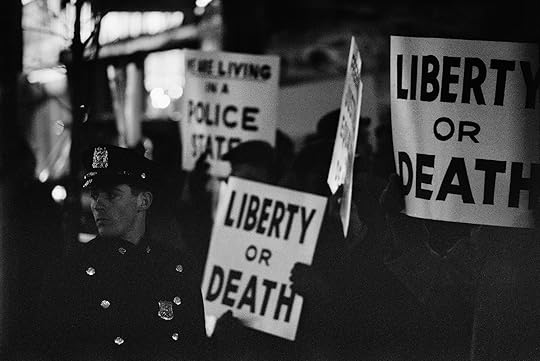
Gordon Parks, Harlem Rally, Harlem, New York, 1963
© and courtesy The Gordon Parks Foundation
I started thinking about Black death well before the global pandemic and global lockdowns and measures of combating and coping that have become our everyday reality. I will never forget the photograph of the brutally beaten and swollen body of the young Emmett Till published in Jet magazine in 1955. Many young people experienced episodes of hostile confrontation with the police that intensified over the years because of social protests. Blacks were being killed, hosed, jailed, and subjected to unjust laws throughout the American landscape. Photographers witnessing both brutal and social assaults created a new visual consciousness for the American public, establishing a visual language of “testifying” about their individual and collective experience. On April 27, 1962, there was a shootout between the Los Angeles police and members of the Nation of Islam (NOI); Ronald Stokes, a member of the Nation of Islam, was killed. Fourteen Muslims were arrested; one was charged with assault with intent to kill and the others with assault and interference with police officers. A year later, Malcolm X investigated the incident and the trial. Noted photographer Gordon Parks remembered his photograph of Malcolm X holding the brutally beaten NOI member in this way:
I recall the night Malcolm spoke after this brother Stokes was killed in Los Angeles, and he was holding up a huge photo showing the autopsy with a bullet hole at [the] back of the head. He was angry then; he was dead angry. It was a huge rally. But he was never out of control. The press tried to project his militancy as wild, unthoughtful, and out of control. But Malcolm was always controlled, always thinking what to do in political arenas.
I share this history, as I am always mindful of the past because of visual culture. I value this history, even though I am distressed by it—even more so because Gordon Parks High School was destroyed by fire in St. Paul, Minnesota, this week.
History!! James Baldwin said, “To accept one’s past—one’s history—is not the same thing as drowning in it; it is learning how to use it.” The last few months have confounded me for a variety of reasons, but perhaps most because Baldwin was meticulous as a writer and did not spare words, thus his use of the verbs learn and use in the above are clear iterations of this, of functionality. Learn to use art (image). And make history right. In 1987, Toni Morrison wrote in Beloved, “And O my people, out yonder, hear me they do not love your neck unnoosed and straight. So love your neck; put a hand on it, grace it, stroke it and hold it up.”
Collectively, we must continue to remember that photography and images can be both empowering and ominous; they can help us make changes to the laws as we struggle to find words for this painful moment. I am encouraged by our students’ activism as they photograph this charged moment, and at the same time, make photographs of the causes of inequities. I urge everyone to use this incredible energy to vote; to document injustices; to be encouraged by the voices of the people around this country telling this story globally and depicting the faces of Breonna Taylor, Ahmaud Arbery, and George Floyd on their face masks, T-shirts, signs, and murals; and to ensure that this will be the last time.
Deborah Willis is professor and chair of the Department of Photography and Imaging at New York University’s Tisch School of the Arts. A version of this text originally appeared on New York University’s website as a letter to students.
Click here for further resources related to supporting Black lives.
Mikael Owunna’s Photographs Show the Essence of Black Healing
In his glittering portraits, the artist is building an alternate world.
By Amber Hickey and Anney Traymany

Mikael Owunna, Emem, from the series Infinite Essence, 2018
Courtesy the artist
“What is the impact,” the photographer Mikael Owunna asks, “when you see somebody who looks like you being killed all of the time?” Owunna, an American photographer of Nigerian Swedish descent who originally studied engineering, makes work about queerness and the Black body, and describes his practice as a direct response to a dominant visual culture pervaded by images of the Black body as a site of death. His series Infinite Essence (2016–ongoing) simultaneously constructs an alternative visual narrative in our present, while gesturing toward the possibility of another world. In order to create these otherworldly images, Owunna uses fluorescent paints to hand paint the bodies of his subjects; the photographs are taken in darkness, punctuated by flashes of ultraviolet light.
We recently spoke to Owunna about the gravity of this series, and how it might be mobilized as a speculative tool of creative resistance. Although most of this conversation was conducted prior to the murder of George Floyd, the video that circulated of Floyd’s death, repeatedly reposted, adds new weight to the question that drives Owunna’s photography: what is that space we can imagine beyond the limits of white supremacy, racism, and violence?
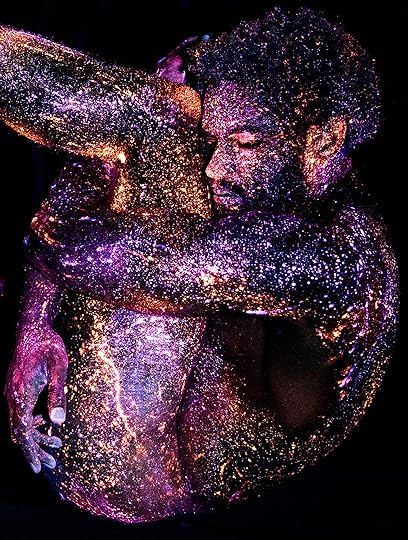
Mikael Owunna, James, from the series Infinite Essence, 2018
Courtesy the artist
Amber Hickey: How have you been holding up this past week?
Mikael Owunna: “How are you?” is the hardest question I’m asked these days. There is no way to quantify or express the level of horror, tragedy, and distress. America’s delight at the spectacle of the public lynching; collapsing public-health infrastructure that already did not serve Black communities; unemployment is skyrocketing; and no comment on how Black unemployment consistently reaches two times the national rate. I don’t know what to say, other than Black Liberation Now.
Anney Traymany: You address a variety of social justice issues, particularly those that directly affect Black communities. Can you talk us through some of your main artistic concerns, what led you to begin your Infinite Essence series, and how this project relates to your other work?
Owunna: With Infinite Essence, I was really struck between 2014 and 2016 by the plethora of images and videos that were being diffused in the media, of Black people being shot and killed by police officers. At first, it was this emotional response of seeing this injustice and being really rallied into action. What I began to notice after several years of this was that there was just this continuous repetition of this image of the Black body being shot and killed, and just falling to the ground. I started thinking about, what is the impact that has when you see somebody who looks like you being killed all of the time? I don’t see this type of imagery, particularly with white people, with white bodies, and so I was asking myself as a photographer and as an engineer, how can I reimagine the Black body in a different way? How can I reimagine the Black body as a space of magic and light? That is the crux of the project. I am constantly thinking about how I can imagine and reimagine universes where people from marginalized backgrounds—particularly Black and LGBTQ people—can be full and complete individuals. It’s the same artistic impulse to reimagine and create worlds—ideal world-building—where marginalized people are full and complete individuals.

Mikael Owunna, Sam, from the series Infinite Essence, 2018
Courtesy the artist
Hickey: Infinite Essence also creatively resists the way Black bodies are often represented in the news, and it points subtly toward the way images of Black folks under duress are sometimes seen as more “valuable” to corporate news outlets and therefore more valuable for journalists and editors, which is of course, a serious problem. But then again, journalists and editors are vulnerable to this economy of images. Do you think they have a role in resisting it?
Owunna: I absolutely do think there’s a role, and there’s an intentionality that’s played by the industry. I think about when Columbine happened, I never saw an image of a dead white teenager. With Sandy Hook, I never saw an image of one of those dead children. The media is not showing us those images. Whereas you have a relationship with Black and Brown bodies, there’s no type of respect that’s given to that body, and as mentioned, it’s open harvest for everybody.
When I was thinking about these police shooting videos that were being shared so widely, I also thought about the history of lynching photos—how photographers would take pictures of victims of lynching, and they would be sold as mementos. I was thinking about the world in which image-makers have been agents of white supremacy and are propagating it. I do think there is a responsibility, and it’s an interesting dynamic in terms of who actually has the agency in those situations. We can talk about how Mamie Till-Mobley, Emmett Till’s mother, chose to display pictures of his body after he was murdered in 1955, and how that had a very different impact, because that was an intentional choice. When Michael Brown was shot and killed, and the image of his body was shared all over the media, that was not with the consent of his family as an intentional choice. And so, I do think there is completely a responsibility, a big responsibility, because images have so much power. Particularly when dealing with marginalized groups who have historically little or poor representation. If you’re filling up that vacuum with destructive images of those communities, that does have an impact.

Mikael Owunna, 4 Queer African Women, Brooklyn, New York, from the series Limitless Africans, 2017
Traymany: Who is this series for?
Owunna: My projects are for myself, first and foremost. I do projects over the course of years. I did Limitless Africans (2019) over the course of six and a half years. I’ve been working on Infinite Essence for three years. For me, there needs to be an internal space of healing that I’m finding in order for it to be a big motivating factor. I am trying to find ways of renegotiating my relationship with my own body as a Black, queer person. I am trying to think about how I was being so deleteriously impacted by seeing these images, and so I wanted to ask, What does an expansive, beautiful representation of the Black body that I want to see, and that would heal me, look like? What could I create around that? Healing is so important for me. And that’s why the images look the way they do, because I’m trying to heal things that I felt were broken within me, and I’m trying to find that universe where we are all full and complete individuals.

Mikael Owunna, Queer Kenyan Twins, Hamburg, Germany, from the series Limitless Africans, 2017
Hickey: In your statement about the series, you ask, “What if the only images you saw of people who looked like you were dead and dying bodies? How would that affect the way you move through the world, how would that enter (and hamper) your body?” How has Infinite Essence affected the bodies of your subjects, as well as those who view the finished work?
Owunna: When the work was shared in an NPR article last year, I got flooded with comments, particularly from other Black people. One that stuck with me was from a sixty-year-old Black woman named Annette. She emailed me and said that she’s a curvy Black woman, and she said that every single day of her life, she has hated her body. Every single day, for sixty years. And when she saw the Infinite Essence series—there is a piece with a curvy, Black woman adorned with stars—she said for the first time, she had a moment where she felt at ease with who she is. When I thought about Annette’s comment, about how she felt that sense of ease for the first time in her life seeing the image, I also thought about how works of art, even hundreds of years old, can affect the ways in which people move through the world. It informed the way I thought about the power of the image to affect community.
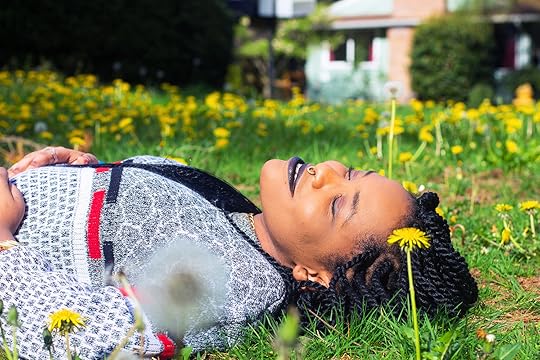
Mikael Owunna, Netsie, Seattle, Washington, from the series Limitless Africans, 2016
Hickey: Why do you choose photography as your medium of intervention?
Owunna: I stumbled into photography. I was studying engineering, and I was really struggling with being a queer, Nigerian immigrant. I was trying to find a creative outlet for myself, and one of my friends jokingly said, before we went to study at Oxford for the summer, “We should take pictures while we’re there!” And I was like, sure. I got a camera, and my uncle, who was an amateur photographer, gave me a lot of tools to think about photography and composition. What I didn’t realize at the time, though, was because I was in such a state of incredible depression and anxiety, I literally didn’t believe or didn’t know how to believe that someone could be queer and African and inhabit the same body. I wasn’t going to therapy, I was eighteen, I was a mess. The camera became this huge creative outlet for me at a time when I had no voice. Maybe because I wasn’t that good at drawing or painting, I suddenly had this tool that could allow me to create images of the world around me, but focus on things that could be a bit more emancipatory than what my day-to-day life was like. And so, I came into it from that perspective of wanting to escape from where I was in my life at the time.
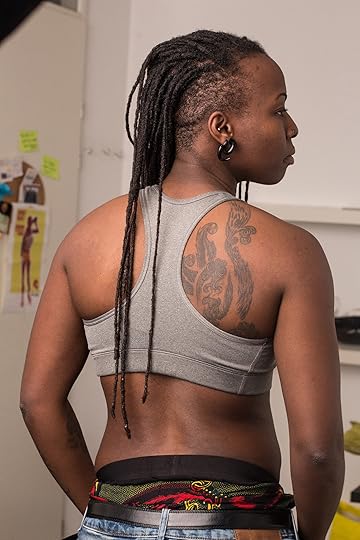
Mikael Owunna, Gray, Amsterdam, from the series Limitless Africans, 2017
Hickey: The historical bias of photographic film is well known—specifically, the way film was originally developed to best capture lighter skin tones, and the problems that has long presented. It seems like your work is responding to that long legacy of misrepresentation of the Black body in photography, through moving beyond documentary photography, toward something more speculative and imaginative.
Owunna: I see myself as standing on the shoulders of the long tradition of Black photographers, playing with and reimagining our uses of this medium to fit our communities. With Infinite Essence, people often don’t think the pieces are photographs. People will be like, “Oh, wow, that’s great digital art!” My mom and aunt will say, “Oh, Chu Chu, your painting!” I think there’s a shift when people understand that the work is a photograph. In fact, there’s an interesting dynamic, because suddenly the way in which they respond to work and respond to the idea that this is a Black person, a Black body, when they understand that it’s a photograph, is totally different than when they think it’s a painting or a graphic. So, I think there is this dynamic that’s happening there when people respond to the work as a photograph, that can then be used as photographic evidence of “there is something different out there.” It’s right within our grasp, but it’s beyond our comprehension, because the photograph captures “reality.” It’s this new way of seeing reality that I think, because it’s understood as a photograph, can shift things.

Mikael Owunna, Sam, from the series Infinite Essence, 2018
Traymany: What is the significance of shooting in the dark? How does that help viewers, or even yourself, challenge the frame, so to speak?
Owunna: There’s a lot of difficulty with shooting in the dark, so one of the things that I’ve started doing is I focus with the light on, then I turn the lights off, and then I photograph. I press down the shutter, and the ultraviolet light will shoot out and illuminate the body for a fraction of a second, and then that’s timed to the camera sensor, which then picks up the fluorescence. I put my camera a little bit down during the shoot so I can look over. It’ll be totally dark, and this glowing figure will emerge from the darkness, and then disappear. I’m really fascinated by the way in which I think about spirit and the way I play with this idea of moving between dimensions. Because we think about the visible spectrum as one sliver of the wavelengths of light that exist. That’s all we can see, as human beings, all we will ever see. I think about how other species can see other wavelengths of light. What if we could see something different? I’m playing with the idea of what is visible and invisible to the current human experience, and ideas of what the body can represent.

Mikael Owunna, Kinya, from the series Infinite Essence, 2017
Traymany: Your work reminds me a lot of Octavia Butler’s and adrienne maree brown’s in terms of how you “write” or, in this case, photograph yourself into the narrative. brown helped to coin the term “visionary fiction” to define genres of writing that offer us alternative worlds. Do you feel like your work is a piece of visionary fiction? Did you have Butler or brown as inspirations in creating this project?
Owunna: Actually, I was reading Butler when I was testing out different concepts. I read Kindred (1979), and I read Imago (1989), which was really good. I read some books from the Patternist series. I read four of her books and for me, the practice that I had when reading her work was in reading the characters as being Black characters. I mean intentionally, when I was reading her work, I was imagining this world, because I visualize everything when I am reading, and I imagined this world and these different figures as being Black people. Whereas I’m used to imagining science fiction figures being white people.
When I was conceptualizing the project, I was specifically referencing a quote by novelist Chinua Achebe, who was talking about the idea of the spirit in the Igbo cosmological system. One of the ideas is that we all have an internal spirit or spiritual guide called chi, and that each of our chi is one ray of the infinite essence of the sun. That’s where the title “Infinite Essence” comes from. This idea that all of our spirits are connected to something that’s far greater and deeper than what meets the eye. With Infinite Essence, I am building a universe that looks different. I am building a world where Black people are magical figures. So it’s not about it being a future, these are present Black bodies that look like this, who then add another element to the world-building that is special to the photographic medium.
Our bodies are made from stardust. All of the iron that is used to bind oxygen in our red blood cells, in hemoglobin, comes from the explosion of supernovas. Gold is formed when two neutron stars in a binary formation spin into each other and explode. That’s why gold is rare, because this element formed from a less frequent collision of stars. I think about this idea of death and rebirth. Death and rebirth, again and again. I think about spaces of healing and these spaces of rebirth, and how we can create something new. That’s what I try to do with my work, is to think about healing and rebirth in the face of what we experience on a day-to-day basis in terms of violence. What is that world that I want to be in, that I want to imagine, that is so much bigger and so much more expansive than the limits we’ve created through hierarchy, white supremacy, capitalism? If we understood that this is what our bodies are made of, how might that change our relationships? Particularly if you come from a marginalized background, what’s possible for you? That’s what makes me excited, to think about sharing my work, and the impact I could have, just leaving it open to breathe.
Amber Hickey is a faculty fellow in American studies at Colby College. Anney Traymany is a student of critical race and ethnic studies at the University of California, Santa Cruz. The authors gratefully acknowledge Stella Gonzalez, who transcribed this interview.
Click here to donate to Black Liberation Organizations.
May 28, 2020
Announcing the 2020 Aperture Summer Open Artists

Seunggu Kim, 15 Globe Amaranth Festival, 2018, from the series Better Days
Aperture is pleased to announce the participating artists in the 2020 Aperture Summer Open, Information. At a moment when ideas about truth and power have been disrupted, these fourteen artists consider how photography portrays and charts our experiences of technology, politics, and the social landscape, from declassified military archives and CIA conspiracy theories, to encounters with race and memory, to the physical spaces where digital information is concealed from the public eye. Together, they broadcast new ways of viewing our present—and our future.
Javier Alvarez / Gus Aronson / Widline Cadet / Emma Cantor / Yu-Chen Chiu / Ash Garwood / Evan Hume / Seunggu Kim / Joshua Rashaad McFadden / Daniel Mebarek / Kean O’Brien / Florence Omotoyo / Rowan Renee / George Selley
The 2020 Aperture Summer Open is curated by Brendan Embser, managing editor of Aperture magazine, with Farah Al Qasimi, artist; Amanda Hajjar, director of exhibitions at Fotografiska; Kristen Lubben, executive director of the Magnum Foundation; and Paul Moakley, editor at large for special projects at TIME.
The Aperture Summer Open is an annual open-submission exhibition. Selected by a jury of leading editors, curators, and writers, the exhibition seeks to reveal and report on key themes and trends driving contemporary photography. The 2020 Aperture Summer Open is presented by Fotografiska New York. Follow @aperturefnd on Instagram and Twitter for news and updates.

Javier Alvarez, Marco Antonio, 42 years old, at his room, São Paulo, Brazil, 2016, from the series Prédio

Gus Aronson, Family Album, 2019, from the series Eurydice
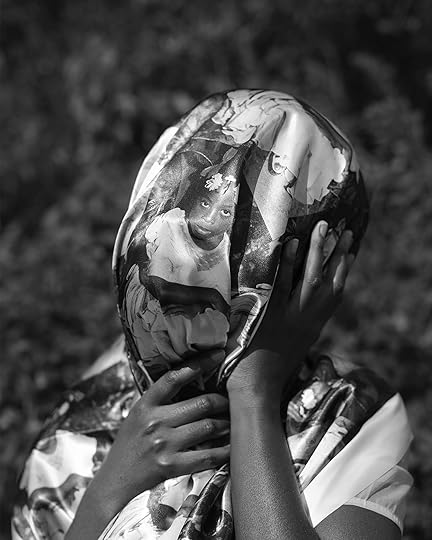
Widline Cadet, Kò an Kòm yon Lokal ki Baze sou Je (The Body as a Site Based on Sight), 2019, from the series Seremoni Disparisyon (Ritual [Dis]appearances)
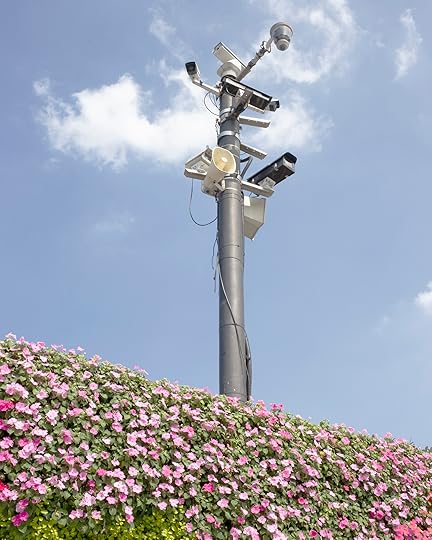
Emma Cantor, Surveillance Cameras, 2019, from the series The Production of Certainty
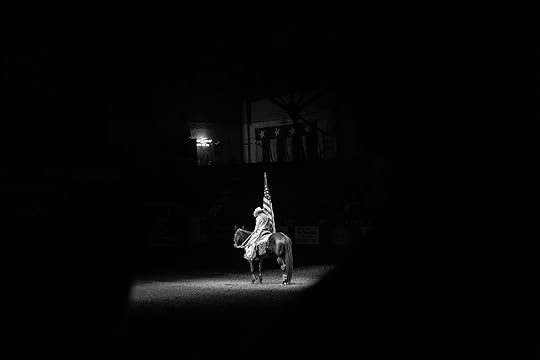
Yu-Chen Chiu, America Seen, Fort Worth, Texas, from the series America Seen

Ash Garwood, Folded and Faulted, 2020, from the series Common Fault
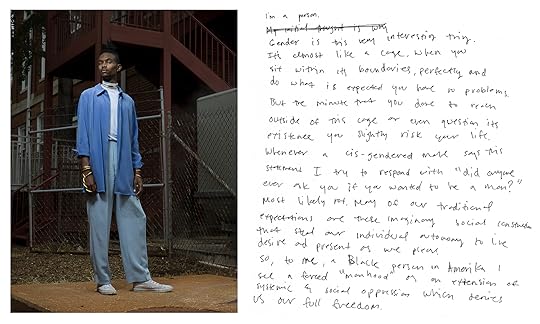
Joshua Rashaad McFadden, Avery Jackson, 2017, from the series Evidence
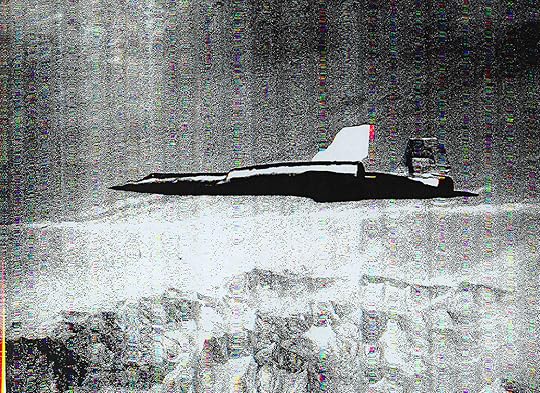
Evan Hume, Project Oxcart (A-12), 2019, from the series Viewing Distance

Daniel Mebarek, Untitled, 2020, from the series La Lucha Continua (The Struggle Continues)
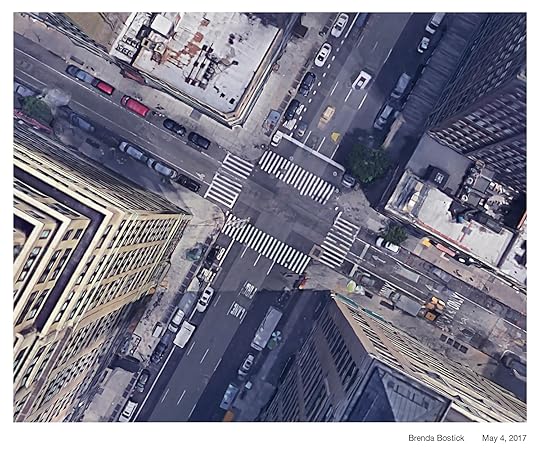
Kean O’Brien, Brenda Bostick, from the series Mapping A Genocide

Florence Omotoyo, Choose love, 2019, from the series Everwhere + Nowhere

Rowan Renee, Evidence #15, 17: Misc Paper from Desk, 2019, from the series No Spirit for Me
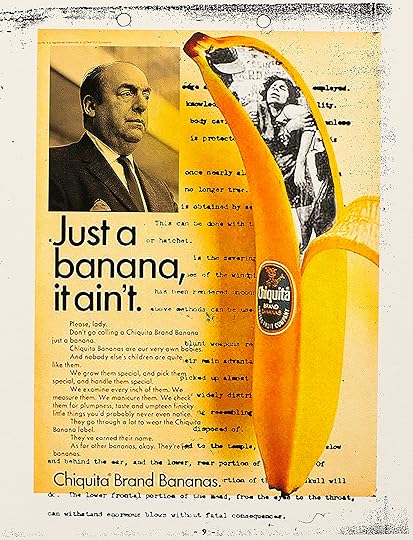
George Selley, The simplest local tools, 2018, from the series A Study of Assassination
All images courtesy the artists.
Subscribe to our newsletter and never miss Aperture’s new releases, latest editorial content, and more.
May 20, 2020
On the Cover: Aperture’s “Ballads” Issue
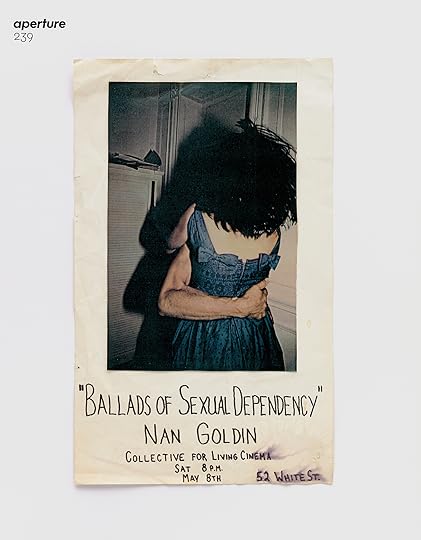
Poster for Ballads of Sexual Dependency, by Nan Goldin, Collective for Living Cinema, New York, May 9, 1983
Courtesy the artist and Marian Goodman Gallery, New York, London, and Paris
Before Nan Goldin’s The Ballad of Sexual Dependency was screened at museums around the world and published by Aperture as a now-classic photobook, there was the live event, announced on posters on the streets of Manhattan and Berlin. “As we said in those years,” Nan Goldin tells Darryl Pinckney in “Ballads,” Aperture’s Summer 2020 issue, “in the ’80s and ’90s, there was no way to see anything unless you were present.”
The Ballad was a performance, often staged in crowded, downtown bars. These were underground happenings, slideshows of almost seven hundred pictures set to music, edited and re-edited, sometimes minutes before. It could be chaotic: slides would get stuck, or projector bulbs would break. The poster on the cover of Aperture, which includes Goldin’s photograph The Hug (1980), was for a screening at Collective for Living Cinema, an artist-run cooperative in Manhattan’s Tribeca neighborhood that showed experimental films.
In the years since Aperture published The Ballad of Sexual Dependency in 1986, Goldin’s tour de force has become an enduring model for photographers across ages and geographies, from Tokyo to New Delhi to Prague. Aperture’s summer issue takes a measure of that dynamic influence, like a song endlessly revised but always recognizable. “Everyone’s obsessed with the ’80s,” says Goldin. “But it must mean more to the kids than just that. They must be able to see themselves in The Ballad. Not just the clothes, but on some emotional level.”
Pre-order Aperture, issue 239, “Ballads,” available June 4, and subscribe to Aperture to never miss an issue.
May 19, 2020
12 Photographers on How to Survive the Lockdown
From Brooklyn to Bangladesh, what to read, watch, and listen to—and why to keep going.

Olgaç Bozalp, Funeral Flower Man, South Korea, February 4, 2020
Olgaç Bozalp
Where are you right now?
I’m in Istanbul. There’s a curfew here, sometimes three days a week, or four days a week. It changes all the time.
If you’re out on the street, they tell you to go home?
There’s a penalty if they see you. When they did it for the first time, they told everyone, maybe at eleven o’clock at night, they said there’s going to be a curfew for two days. It’s going to start at 12:00 a.m. And everybody went outside to stock up on some food. It was insane on the streets.
Then everyone’s crowding!
Yeah, exactly. I originally came here for a shoot for Dazed. I was going to stay for another week, then I was going to go back to London. Then my flight got canceled.
What was the commission for Dazed?
There’s this group of guys in Turkey, they have this kind of spiky hairstyle. They call themselves “Apache.” More of them are usually around the Mediterranean side of Turkey, and I wanted to do a documentary about them, and also wanted to photograph them for a while.
What do you think is going to happen in terms of fashion editorial work?
I think it’s already hard to make money in fashion, especially for creators. I feel like fashion is a big luxurious thing for people. This is not the priority, in my opinion, especially in times like this. Why do you need to shoot a fashion photograph? I feel like documentary photography might survive, but fashion photography will struggle.
You recently made a project for Atmos magazine about Songdo, a new city in South Korea two hours from Seoul. Why were you interested in Songdo?
I was doing research about future cities in the world, how are we going to live in the future. I was originally going to go to China before the virus. But there are other “smart” cities—I found some in Malaysia. And then I found the one in South Korea. I was curious to find out how they can be so sure how we’re going to live in the future, and I’m going to go see it with my own eyes. This was in January.
Were people in South Korea already taking precautions, like wearing masks on the street?
Extremely. It was pretty much everywhere in South Korea, every entry to metro stations, sanitizers, signs everywhere. I was wearing a mask. I shot the story in Songdo. It’s extremely expensive; they call it a ghost town. Because of the virus, it was completely empty.
Did you have a fixer there to get models for you? Or did you scout them on the street?
I showed up there by myself. I tried to find someone before I got there, but everyone said no, I think because of the virus. One of my friends introduced me to someone at one of the biggest modeling agencies, who then introduced me to an art director. He studied at Central Saint Martins in London. He did some of the set design, he took me to markets, and I photographed him as well. We kept it very simple.
Will you stay in Istanbul until you feel okay about going back to London?
First, these travel restrictions need to end, and I don’t really know when this is going to end. I don’t know what’s going to happen with the world.
What are you listening to, or engaging with, or watching at the moment?
I’m watching quite a lot of documentaries. I was actually watching a documentary on VICE about Iran, about how they are coping with the coronavirus and U.S. sanctions. And during the week, I’m mostly working on the video documentary I shot about the “Apache” guys.
Do you have any advice for photographers out there about how to keep going at the moment?
We need to look at things from a different perspective. I think everyone had ways of seeing things or looking at things in the past, and now maybe it’s time to change that perspective a little. That’s including me as well.

KangHee Kim, Quarantine, 2020
KangHee Kim
Where are you right now?
Bayside, Queens.
How are you keeping yourself creative during this time?
I make work almost every morning. I try to shoot as much as possible while running essential errands or taking walks in my neighborhood. I find experimenting with cooking keeps me creative and allows me to keep a good balance during the quarantine.
Do you have a daily routine? What are you currently working on?
I wake up pretty early in the morning. Make myself breakfast. I check my emails and clean my room. I usually work on my personal project Street Errands in the morning, because it sets me in a good state to start the day. Then I work on my commissions in the afternoon. I take walks or work out to stay mentally healthy. I end my day reading.
Do you have any advice for artists right now?
The most important thing is to stay physically and mentally healthy. The time we have due to stay-at-home orders could be utilized in a positive way for artists to really sit down and think about work. The solitary practice is absolutely needed in art, and this might be the time for us, by following the laws.
What is something you’re watching, reading, or looking at right now?
I have been listening to New York Governor Andrew Cuomo talk every morning. I am consistently reading the news. I have been reading multiple books at a time: I am currently reading Seeing Is Forgetting the Name of the Thing One Sees (2009) by Robert Irwin, Men Without Women (2017) by Haruki Murakami, and Understanding a Photograph (2013) by John Berger; and I just finished How to Be an Artist (2020) by Jerry Saltz.
Has COVID-19 changed the way you create work?
I devote more time to creating work to overcome my anxiety. I especially spent a lot of time trying to calm myself during the peak phases. Prior to COVID-19, I had been moving my attention to photos taken outside of New York—but now I’ve turned my attention to my surroundings, such as my apartment and my neighborhood, which is where I first started my project.
As a DACA recipient, you’ve been unable to leave the U.S. in over a decade. You have described your work as constructing your own form of “surreal escapism.” This idea feels especially relevant now, with travel restrictions and stay-at-home orders. In light of what’s going on, have you been reevaluating your work?
It feels like an extreme version of what I have been dealing with. I had never imagined the world would experience stay-at-home orders. I find it outrageous to see people relating to my experience because of the travel restrictions. I realized with DACA, I was fortunate enough to be restricted in the States. Today, the ordinary is even more the extraordinary, and this is the time that I desire to construct my own form of surreal escapism more than ever. At the same time, I appreciate what is given at the moment. I will be longing for freedom, but I am curious to see how it is going to affect the way I think of my DACA situation after COVID-19.
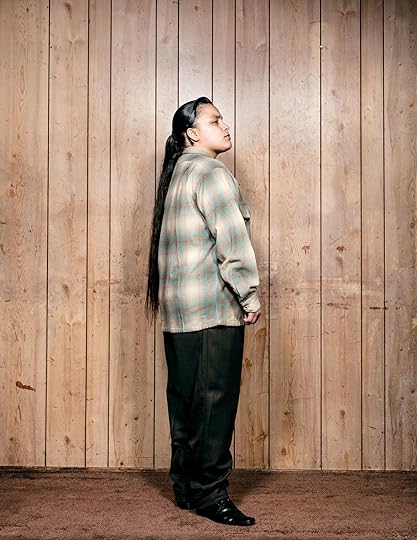
Stefan Ruiz, Maritza Amezcua, 2017, for Vogue
Stefan Ruiz
Where are you right now?
I’m at home, in Brooklyn.
You usually travel a lot. Is this the longest time you’ve been grounded?
I don’t know if it’s the longest, but yeah, it’s kind of getting there, for sure.
What was the last commission, or the last project, you were working on right before the lockdown?
Right before the lockdown, the last thing I did was on March 15; I did a shoot for American Vogue, some portraits. We had to switch studios at the last minute. We all knew that was the last shoot for a while. Everyone knew it was coming. Everyone’s trying not to touch each other, but obviously, on a fashion shoot, you have to. The stylist is adjusting the clothes, there’s definitely hair and makeup. Social distancing doesn’t work with a fashion shoot.
Do you think people are going to have to figure out how to do their own makeup?
I’m sure people have been doing that now already, on their Instagram or YouTube videos. A lot of people you’ll see are wearing hats, but then you see someone like Cardi B, and she’s completely done up. She’s fairly savvy.
How are you keeping creative at the moment? What are you reading, what are you listening to, how are you filling your time?
I’m kind of a notorious collector, so I have all kinds of shit here. I’ve got a million things to either look at or go through, or work on, or listen to, or try to organize. Right now, actually, I’ve just been organizing books. Luckily, I traveled a lot right before this whole pandemic started. I was in Brazil for a couple weeks, and before that I was in Argentina, and then Chile. I collect records, and I bought a lot of records in Brazil.
Is there an album that you’ve recently discovered?
One I’ve been listening to a fair amount is Tim Maia. He kind of brought R&B to Brazil, and then combined it with Brazilian music in the early ’70s. He’s famous for that. For a while, he joined a cult, and he made a couple records when he was in the cult. They’re amazing. I have one of them, it’s called Racional (1975). There’s Volume 1 and Volume 2. Volume 2 is extra expensive, probably $500 or something, if you can find it [laughs]. I don’t have that one, but I have Volume 1.
Have you had any editorial commissions during this time?
I was asked to do a self-portrait for American Vogue. I didn’t really want to do a self-portrait, because there are so many selfies out there. I just took some pictures of things I was doing, or things I was seeing, and put them together and sent them.
What kind of images would you want to make now, as we move ahead?
I like doing portraits for sure, and personally, I’d like to work on some of my own stuff. In some ways, this is kind of good. At the same time, I need to make money. And I’ve been able to make money working for magazines, doing some advertising or whatever, for years. It’s kind of weird now, because that’s all just dropped out.
What personal projects are you working on?
I’ve worked a lot in Latin America on a really wide-ranging project that needs to be pulled together. Roughly, that project is about exploitation.
Do you have any advice for photographers out there right now?
I’m trying to figure it out for myself. I think it’s a great opportunity to focus on your own stuff or ideas, because there aren’t that many interruptions. Obviously, photography has become—it’s become harder and harder to make money. I think most people still need to make money one way or another. I don’t know what I could recommend for that. I would say, do probably what I’d never do, and simplify what you’re doing! And focus on it, and try to come out with something for whenever this ends.

Lieko Shiga, from the series Human Spring, 2018–19
Lieko Shiga
Where are you right now?
Miyagi Prefecture, Japan. I’m living in a part of the countryside named “small cow fields.”
How are you keeping yourself creative during this time?
I had a lot of work to do in my studio, so I’m focusing on that. And there were a lot of books I wanted to read, so now I can spend time reading them. I also talk with my friends online sometimes.
What books in particular?
The Persistence of Vision (1978) by John Varley, and many books by Jun Yonaha.
What does your daily routine look like?
7:00 a.m. — Wake up and go to the farm and work
8:30 a.m. — Cook breakfast and eat
9:30 a.m. — Play with the children and start work
12:00 p.m. — Cook lunch and eat
1:30 p.m. — Play with the children and work, sometimes go to the supermarket
5:30 p.m. — Take a walk with my kid
6:30 p.m. — Cook dinner and eat, then help my kid take a bath or shower
9:00 p.m. — Put the children to sleep, then go back to work, maybe focus on reading this time
12:00 a.m. — Sleep
Do you have any advice for artists right now?
The situation is very different and depends on each artist. So, I would like to say, just simply, let’s live while being considerate of others.
Are you currently working on something new?
Yes, I’m preparing some installations and video works and a garden installation. And I’ve just started Independent Bookstore Print Editions in Miyagi Prefecture.
How has the pandemic affected the arts in Japan?
I’m living in the countryside, so I don’t know the Tokyo situation well. But I guess it’s become a very precious experience to visit galleries and museums. I’m afraid that everything will shift online. The photographic image is like the “eternal present” (in the words of Bin Kimura, psychiatrist), so I’m afraid every experiment goes like a photographic image. I would like to resist the online world a little.

Matthew Leifheit, Reid Bartelme (top left), in Los Angeles, and Jack Ferver (top right), in New York, 2020, for the New York Times
Matthew Leifheit
Where are you right now?
I have been sheltering in a remote place on Fire Island, New York, with my dog and my boyfriend since the middle of March.
How are you keeping yourself creative during this time?
Ugh, I don’t know . . . If I have gotten any introspection done it comes in sort of manic flashes. I am trying to photograph. I am working on a long-term project about Fire Island, which is set at night, so at first I thought I would be getting a lot of work done here. Usually I love photographing people, but I have been challenging myself to photograph more landscapes, and this time seems perfect for that. Some nights I go out, but often it’s been very cold by the ocean and I opt to stay inside and watch a movie or read. My lab is closed, so I can’t see what I’m doing; I think some of the pictures might be good, but you really never know. There is something comforting about the undeveloped rolls starting to accumulate because in my mind, the pictures can be as brilliant as I want.
I also have a show up currently at Deli Gallery in Brooklyn, which was scheduled to open March 29, and after stay-at-home orders went into effect, it became a virtual viewing room. We had an “opening” for the show on Zoom, featuring a nude cellist playing Bach solos from his living room. We also held a poetry reading “at” the gallery in honor of the launch of my friend Paul Legault’s new book The Tower (2020), with readings by Elaine Kahn, Cole Lu, Justin Phillip Reed, and Ian Williams, in addition to Paul.
What does your daily routine look like?
Absinthe at ten, clean off my camera lenses at eleven, maraschino cherries ONLY until four, then a pickle and emails.
Is there any piece of advice you have for artists right now?
No. I feel like people are having such different experiences of the pandemic, I don’t think there is any kind of generalized advice I could give. We’re all figuring it out.
What is something you’re engaging with right now—whether reading, watching, or listening?
The website Emmazed, which is a project of the amazing Mo Mfinanga, has been hosting a Digital Discourse series of live conversations with photographers. You can watch them online on Mo’s site, which is one of my favorite places to find conversations around new photography.
I watched the movie Love! Valour! Compassion! (1997), which I heard about on the WFMU radio show Polyglot with Jesse Dorris. It’s based on the play by Terrence McNally, who died from complications of COVID in March. It’s about a group of gay friends in the mid ’90s who go to a house upstate, and the relationships and dynamics between them—and also racism and AIDS.
I also recently saw The Eyes of Laura Mars (1978) and don’t know how I spent the last ten years in photography without being recommended this film. Spectacular eye acting on the part of Faye Dunaway.
You’re also a publisher of MATTE magazine. Are you working on a new issue?
Beyond attempting to make my own photographs, I am still working on the upcoming issues of MATTE, which will feature the work of Chanell Stone, an extremely talented photographer who recently graduated from California College of the Arts. I first saw her work when I was on the jury for last year’s Aperture Summer Open. Other issues will look at Leor Miller, a recent Bard graduate, who has been making amazing work related to selfhood, hallucinations, and mysticism; and Shohei Miyachi, who is a genius and my colleague at Pratt Institute. We are publishing his series Rakuen, pictures made in adult theaters in Tokyo.
You recently made a portrait for the New York Times via Zoom, which involved bathtubs in Upstate New York and LA—and you made a behind-the-scenes video for Instagram. What was your inspiration for these?
The Zoom bathtub portraits were for an article on Reid Bartelme and Jack Ferver’s podcast Dance and Stuff. As a product of the assignment, I fell in love with the podcast and feel strongly that everyone should listen to it. I had the idea of photographing them in their tubs because of an anecdote I heard on their show about staying connected with friends by FaceTiming in the tub. And my editor, Jessie Wender, trusted me enough to say that we could try this as an option if Reid and Jack liked the idea. It was a fun shoot to do, ended up working for the story, and I really think those guys are the greatest.
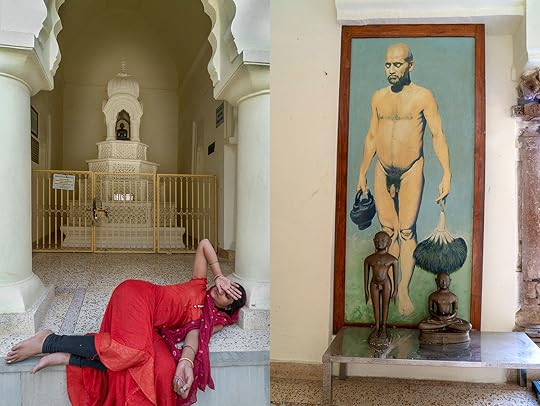
Pablo Ortíz Monasterio, Khajuraho, India, March 2020, from the series Sacred Beasts
Pablo Ortíz Monasterio
Where are you right now?
I was traveling in India until mid-March, taking pictures for a project called Sacred Beasts. Things started to get complicated and dangerous, so we shortened the trip. We came back from Delhi through New York; we did a strict quarantine when we finally got to Mexico City, and since then, I have been at home and sharing time with Paula, mi compañera.
What does your daily routine look like?
In the mornings, I do some exercise, gardening, lunch, read the news. The afternoon is for photographic work, editing, scanning, and retouching to get the final image—and to my surprise, social media. For a long time, I have been distant and critical of how photographs are presented and seen on social media. Most pictures end up being about composition; there is no context to read the image. The “random” order of Instagram produces visual noise and generates surface reading, anecdotes and composition, basically.
In the late 1970s, I did my first long-term project with an Indian community of fishermen on the coast of Oaxaca, the Huave. I had not seen the work since we published the book Los pueblos del viento (The people of the wind) (1981). I pulled out the old 35 mm black-and-white negatives to digitize the photos we used for the book back in 1981, and also to look for “new” pictures. The process was interesting. I was looking and thinking about the Huave people; at the same time, I was thinking about the young photographer I was back then. I can say I am not a better photographer now, but yes, I am wiser.
The confinement gave me time to start an old scanner (an Imacon), slow but very fine and precise. After three weeks of intense work, I had 150 pictures that I liked and wanted to share them. During those long hours of desk work, I was wondering if there could be a way to present a body of work that can construct a more complex view of reality on a platform like Instagram. So I gave it a try and published fifty pictures (two or three a day) on Instagram of The people of the wind. Although the trip in India had to be shortened, I brought back plenty of surprising images. My next project for Instagram is thirty pictures from the series Sacred Beasts in India.
What are you reading, watching, or listening to right now? Are there any photobooks from your collection that you’ve returned to recently?
After my first visit to India, I remained fascinated with the region, so I am reading a long essay written by Octavio Paz, beautiful and enlightening: “Vislumbres de la India” (1995). I have seen some interesting documentaries from the Ambulante Documentary Film Festival presented digitally. And a few days before the trip to India, I found at a street book vendor’s the set of six books Iglesias de México, with text and drawings by Dr. Atl and photographs by Guillermo Kahlo (Frida’s father). Published from 1924 to 1927 in Mexico, the layout and production are wonderful. It’s my new jewel, and I am fascinated with it.
Do you have any advice for artists during this time?
Work and work and have fun and work some more.

Tahia Farhin Haque, Reaching out to the other side, Dhaka, 2020, from the series Colors in Confinement
Tahia Farhin Haque
Where are you right now?
I am from Bangladesh. I am currently living in the capital city, Dhaka, where I have been at home with my family.
What does your daily routine look like?
My routine has been very different than usual. The confinement and constrictions have made it impossible to be out and explore our intriguing world, but for the betterment of others and ourselves, we have to self-quarantine. The daily routine now comprises household chores, reading books, keeping in touch with loved ones. It’s the month of Ramadan, so the preparation for the meal to break our fast and all the washing afterwards takes up a huge chunk of time. Whenever I can, I work on my visual art and enhancing my knowledge.
What have you been reading, watching, listening to, or looking at?
I have been reading Yuval Noah Harari’s Sapiens (2014), and I finished a book called Interpreter of Maladies (1999) by Jhumpa Lahiri. I have been watching old movies, like Satyajit Ray’s Charulata (1964) and Alfred Hitchcock’s Vertigo (1958), and listening to old Bangla and Hindi songs from the 1970s through the ’90s.
I have also been looking for opportunities to engage on Instagram with my audience and other content creators; and curating, handling, and sharing certain social-media accounts of artists/organizations that encourage artists. I have been actively sharing causes that help marginalized communities in these trying times; some of my friends are working to provide essential items, so I try to connect through social media as much as I can from my home.
Are you currently working on something new—or hoping to start or restart a project once isolation comes to an end? How you think your work will change after the pandemic?
I am working on a project called Colors of Confinement. I have also been working on a few other projects, which I will execute once the lockdown lifts and everything goes back to normal, but at the end of the day, the definition of the norm has changed, and I feel we have to be thankful and show great empathy towards each other, as well as put effort into our work to make it empathetic. My work will not change after the pandemic, but the way it is portrayed may change.
What are your concerns for artists and photographers in your community? Do you have any advice for artists during this time?
Artists and photographers are going to find themselves in a very unique space. Exhibitions and festivals may take some time to get back into full swing. Artists also now have to be aware of the projects they undertake and the medium they choose for expression. Art is always going to be there, and in times of pandemic, art will be the torchbearer for joy and hope. As artists, we need to consciously work on painting a picture that expresses the story of our collective struggle as humans and simultaneously encapsulate all the emotions involved.
I use the word empathy a lot, and I have to reiterate it again and again, to show our work in a way that is inclusive and free of bigotry. When reality is a nightmare, it’s up to the artists to bring art that can give a sense of belonging and make us feel, because humans are getting desensitized with this enormous COVID-19 crisis. It’s necessary, more than ever, to create art that is free of racism, sexism, and bigotry, and makes us feel again.

Bobby Doherty, Untitled, 2020
Bobby Doherty
Where are you right now?
I live in Brooklyn.
How are you keeping yourself creative during this time?
I’ve been making lots of photos. I like making photos on a small scale.
Do you have a daily routine?
I normally wake up and make coffee. I do a crossword in bed and drink the coffee. Then I eat breakfast. Then, I don’t know. Some days I have actual work to do, and some days I have nothing. I don’t like having set schedules.
What advice would you give to artists right now?
Go look at a flower.
Have you been listening to anything lately?
I’ve been listening to Faith (1981) by The Cure a lot.
Are you currently working on something?
Same Paper asked me to make some photos for a new magazine they’re making. The assignment was pretty simple, but I’ve had a lot of time to make it complicated!
You have been making a lot of still lifes lately—for stories about voting rights for the New York Times Magazine, “preppers” for the New York Times, and takeout for the Wall Street Journal. What’s it been like to create stories about the current situation?
Yeah, I’ve definitely been on the COVID still-life beat recently. Photo editors have just been mailing me stuff, and I’ve been shooting it in my studio. My studio is a twenty-minute walk from my apartment. I like working alone and I hate not working, so this has been a pretty good situation for me so far.
Do you feel like COVID-19 has changed certain aspects of your practice?
Well, I used to be able to shop around and find cool stuff to take pics of. That’s mostly gone. I basically just take photos of stuff I can buy from the few grocery stores in between my apartment and my studio. But I think it’s good to have creative restrictions. My pics were pretty simple before, and they’re pretty simple now.

Kathya Maria Landeros, Kimberly and Anali, Eastern Washington, 2019
Kathya Maria Landeros
Where are you right now?
Currently, my family and I are in Medford, Massachusetts. In October, we relocated here for work. Had I known everything would go online a few months later, I probably would have considered signing a shorter lease and spending my time in California, closer to the rest of my family members and loved ones. I’m living in an apartment, but lately I’m imagining my life somewhere with outdoor space, good light, and warmer weather, in order to garden and make more pictures.
Have you been teaching this semester?
I’m very fortunate to work in the Photography Department at MassArt, where I have wonderful colleagues. Everyone made the effort to understand the needs of our students as they navigate this new landscape. There were so many circumstances to consider, from students who have lost their jobs, or were uprooted and had to find a new place to live. The shutdown occurred while we were away on spring break, so the first couple of weeks meant figuring out where everyone was and making sure they were doing well, and then trying to mold a flexible curriculum with the understanding that people may not have access to camera equipment or a reliable computer and internet access.
How did you adapt to working with your students?
That question has weighed on me heavily the past few weeks. Both classes I am teaching this semester were darkroom-based. One was black-and-white large format for second-year photo majors; and the second, an open elective called Drawing with Light, a process-based and experimental class. Large-format camerawork turned into whatever cameras they had available, and shifting entirely away from darkroom technique to a curriculum centered around discussions on making and reading photographs. At the beginning, we were looking at a lot of work by other photographers. As the weeks progressed, however, we’ve spent most of our time talking about the new images they are making at home, how they are feeling and navigating this moment in time, the challenges and surprises they are presented with.
In my elective class, we are using whatever materials are on hand, or that are readily available to purchase online. My students have used various processes, including collage, cyanotypes, anthotypes, camera obscuras, cliché verres, and shadow drawings. Their last assignment dealt with the observation of light, creating light sculptures with anything in their house that could refract light or cast shadows in interesting ways. It’s an assignment that’s focused on the act of observation and finding joy in the mundane.
How are you keeping yourself creative during this time?
My practice is very much rooted in engaging with people, and I’ve come to accept that this won’t happen for a while. In keeping my own advice to students in mind, I am trying to find the small moments of beauty and pleasure. My daughter is a young toddler and at an age where, developmentally, every day feels momentous. She inspires me to try to see things with some wonder. Weather permitting, and abiding by social-distancing measures, I try to walk with her outdoors as much as possible. Being outdoors is not only a critical component of my emotional well-being, but it’s the only time, aside from my dreams at night, when I am able to indulge and get lost in my thoughts.
What have you been reading or watching?
I recently finished reading the novel The Rain God (1984) by Arturo Islas, about a Mexican family along the U.S.-Mexico border. I am slowly perusing Ocean Vuong’s On Earth We’re Briefly Gorgeous (2019), and I keep revisiting certain passages for their beauty of language and observation. I am also watching a show called Vida about two Mexican American sisters in Boyle Heights, Los Angeles. And whenever I want to think about my grandmother and mother, or want to have a good cry while dancing with my daughter, I listen to “Amor Eterno.” Santa Cecilia’s version is especially melancholic and beautiful, although growing up, I listened to Rocio Durcal or Juan Gabriel singing it.
Are you currently working on something new—or hoping to start or restart a project once isolation comes to an end?
I’m on a Guggenheim Fellowship that was to end officially in June, and the plan was to continue photographing in Mexican American communities this summer. My hope is to carry on as soon as I can, most likely next year. In the meantime, I am editing all the work I did last summer on the fellowship and bringing the two chapters of work, Dulce and West, to a conclusion by making handmade artist books. This entails a lot of color correcting, ICC profiling, and printing, all of which I can do while working from home.
With some of my fellowship money, I recently splurged on a used Jobo tank to process large-format film in daylight. My fridge is full of film that needs to be processed and edited into something cohesive. I also have some expired darkroom paper that I plan to make sun lumens with during this time at home.
Do you have any advice for artists during this time?
This pandemic has exposed how vulnerable we are as a society and inequalities that we can’t ignore any longer. I’ve been thinking a lot about this recently, and what our postpandemic society will look like. How will artists respond to this moment? What is our responsibility for doing so? I guess it’s more a question than advice. I hope that we can absorb the magnitude of what we are living through and let it serve as a catalyst for much-needed change.

Abdo Shanan, Untitled, April 4, 2020
Abdo Shanan
Where are you right now?
I am based in Algiers. It is where I am spending these lockdown days.
What does your daily routine look like?
I try to walk as much as possible. It is really frustrating not to be able to walk as much as I did before the lockdown. Walking is an important part of my daily routine; it’s a moment of reflection for me. One thing that hasn’t changed is waking up early every day. I think that’s when I am most productive. I get some work done: research and applying for grants and funds to finish my ongoing project Dry, and to finally be able to produce a book with it. Lately, as part of my research, I have started to learn bookbinding, not that I want to be perfect at it, but I consider understanding and learning all aspects of book production an important part of research.
What are you reading, listening to, and engaging with right now?
I have been listening a lot to Tindersticks and Godspeed You! Black Emperor. For some reason, their music allows me to escape. I tried to follow some Instagram Live videos that provide interesting content about photographers and photography, but soon I became inpatient. I think part of me is refusing to accept all of this as a new reality, even if it is for a defined period. Next week, I will go back to reading The Return (2016) by Hisham Matar. I think all I am looking for is escaping.
Can you talk about the Polaroids you’ve been making and posting to Instagram?
These Polaroids came out of my need to express how I feel. I have no plans for these photos; they are just the words and phrases that I could not say in a conversation with people I am not meeting anymore. Lately, I’ve started to think that the world looks like how I felt back then, while I was working on Diary: Exile (2014–16), the same feeling of loneliness in a vast space. Only this time, I don’t think I need a flash and high-contrast black and white to show how I feel; I just have to photograph the world around me as it is, adding a bit of my feelings to the images. In this sense, the Polaroids allowed me to do that. I think it’s worth mentioning that these Polaroids are digital ones: I use a filter on my phone to make these photos. Real Polaroids becomes a luxury when you cannot travel abroad.
How do you think your work will change after the pandemic?
Not only work will change, life itself will change. On the other hand, I don’t think that the pandemic will be over anytime soon, hence I am more concerned about that period that seems to be going for longer. I cannot imagine photographing masked people—I need their full facial expressions—nor photographing people from a distance. I think about it every day. For example, I intend to finish Dry by next year. But to do so, I need to meet people, to interview them, and to photograph them at a close distance. How will it be possible? A question I need to find an answer to.
What are your concerns for artists and photographers in your community? Do you have any advice for artists during this time?
We are worried to see the government taking advantage of the situation that the pandemic created—imposing new laws restricting freedom of speech and creation under the pretext of fighting hate speech and fake news. I can see the space of freedom shrinking every day. I think as artists, we need to soldier on and work together to expand the field of the possible, as my friend Salah Badis describes freedom. We are stronger together—intellectually and physically. Power to the artists and to the souls fighting to create.

RaMell Ross, Man, which is his nickname, 2019
RaMell Ross
Where are you right now?
I’ve been solely in Providence, Rhode Island.
Are you teaching this semester?
Yes, it’s so strange. I have one class that’s been successful because it’s pretty malleable. It’s called Other Lives of Time, which I created based on this program that I made for Full Frame Documentary Film Festival at the Museum of the Moving Image in Queens. It looks at contemporary notions of time and poetics in fiction and nonfiction cinema. It’s about transporting your own personal relationship into cinema. So that one was fine. But my black-and-white photography class, which was all analog and in the darkroom, kind of bottomed out. So I had to recalibrate and do it over Zoom. Which was really bizarre. Everything becomes digital art on Zoom. In the darkroom, it’s about attention, and the slowness that process takes. The only way I could figure out a parallel within this short period of time was to ask students to build images, or think about photography as construction, and less as capture.
Do you think at the other end of this, there will be a greater appreciation for materiality?
That’s such a philosophical question for me. Digital interfaces activate an evolution toward that reality being desired and normal, and shift us away from the needs of being in the material world. Are we becoming more capable of finding the nuances? Or are we being prepped for a digital world? At what point does that become normal? It’s kind of scary.
How have things changed for your personal work?
I went into this whole pandemic quarantine thing with the big, American, capitalist, hyperproductivity drive, like, I’m going to do everything. I guess I underestimated the cultural, emotional, psychological shift that happened almost collectively. I haven’t been able to be as productive as I’d imagined. But I’ve been able to slow down in a new way. I think I’m always a slow, attention-to-detail-oriented person in terms of art-making. I photograph in Alabama exclusively, almost as a political statement to work in the South. I’m heading there in about three weeks. The internet there is so bad; I couldn’t go there and continue teaching remotely. Now I can go there, because I don’t have internet responsibilities.
What are your creative distractions at the moment?
I’m reading two really good books right now. One is called The Old Drift (2019) by Namwali Serpell. Holy shit! What a longitudinal masterpiece. I’m also reading The Warmth of Other Suns (2010) by Isabel Wilkerson. I love epics.
Can you tell us about this new picture Man, which is his nickname (2019)?
It fits into something I’m trying to distill into better language, but it’s quite natural to my work. I look at The New Black Vanguard (Aperture, 2019), and using that as a marker, and using this image as a marker, I’m very interested in how to display notions of what it means to be a person in the world, and then a person of color in the world, in the flow of the daily relationship to regular objects. To me, the relationship between man and the machine, and between humans and technology, like who is using whom, is also the relationship between person and society, being both an agent and an object of meaning—that is kind of what I was getting at.

Jody Rogac, Kristin, 2020
Jody Rogac
Where are you right now?
Brooklyn.
What was the last assignment you had before things changed?
It was a great one! It was for Penguin, with soccer player Megan Rapinoe. She’s coming out with a memoir, so it was a portrait session with her for the cover. Shoots were getting canceled here and there, and I was waiting for this to be canceled as well, but I’m glad it wasn’t. She was scheduled to come straight to the studio from the airport; she was flying in from Texas, I think. We all just waved at each other. No one touched. This was March 12.
Right up against the stay-at-home order.
Yeah, it was a lovely one to end on.
You had a sense then that things were slowing down?
I had a shoot booked for that Monday, which had canceled. You could just feel it in the air. That anxiety was building, that tension of people being aware of the speed of the germs, the changing air around everybody.
What professional work have you had since?
I haven’t received any assignments to do in isolation, but I’m kind of happy with that, to be perfectly honest. I’m spending the time taking a break from thinking about making work for anyone else.
What type of work do you make for yourself?
I’m taking figure-drawing classes via Zoom and getting back into that, which is something I really enjoy and never make the time for. (It’s kind of like exercising.) I’ve been working on a book edit for a long time. I have a printer here at home, so I’m working on a sequence, and as soon as businesses are open, I’ll bring the pages to get it bound to make a dummy. I have a dog, and I live about twenty minutes from Prospect Park, so I’ve been walking him there in the mornings and just making pictures—taking the time to roam around and explore and shoot for no reason except that it’s enjoyable, which is so easy to lose sight of when you’re using photography as a way to make a living.
You were one of the organizers of Pictures for Elmhurst, a fundraiser in support of Elmhurst Hospital Center in Queens. The sale of prints donated by 187 artists raised $1.3 million. How did this idea start?
In the very beginning of April, I started texting with my friend Samantha Casolari. She’s Italian, but she’s lived in New York for many years. There was a similar fundraiser in Italy, for the Pope John XXIII Hospital in Bergamo, and she was asked to donate an image for that. It started like a school project, like, wouldn’t it be cool if we could do something like that for New York? At the time, Elmhurst was getting hit so hard, it was at the epicenter of everything. The need was so urgent. So she and I and a mutual friend, Vittoria Cerciello, started hitting up our network, and one thing led to another. My partner, Matthew Booth, got involved, and so did Shayna McClelland, Eliona Cela, Stefan Durgan. We had never organized or fundraised for anything. We definitely pulled all-nighters, trying to get things ready, figuring out the website, handling the outreach to artists. I’m really surprised by the result. It shaped this whole lockdown experience for me in a way I couldn’t have expected.
What are you reading or watching that has kept you going—or kept you sane?
I’m currently watching The Last Dance, the NBA documentary. It’s so good! And I’m currently reading Labyrinths (1962) by Jorge Luis Borges—I’m loving that—and I just finished Orlando (1928) by Virginia Woolf.
What do you think is the way forward for portraiture and editorial commissions?
There’s always going to be a need for portraiture. It’s such a relevant art form. It’s just going to depend on the logistics of being careful with distance and touching—like with my shoot with Megan. I have to hope that the assignments will start coming in soon. I find it encouraging that clients are starting to reach out.
Do you have any advice, especially for younger photographers? So many students just had their last semester waylaid by the crisis.
I think it would be the same advice, pandemic or not. Just make the work you’re passionate about. Just be fully yourself in everything you make. There are always ways to make work. Just don’t stop.
Interviews by Brendan Embser and Cassidy Paul.
Subscribe to Aperture and never miss an issue.
Aperture's Blog
- Aperture's profile
- 21 followers



